HGSS Gives Important Advice to Hikers Ahead of the Season
June 4, 2022 - Summer is the most popular time of year for hiking in Croatia's national parks. However, many are unaware of the unpredictable conditions that could put one or more lives at risk, which is why Mario Saban from HGSS has decided to dish out some important advice for those interested in hiking in national parks.
The Croatian Mountain Rescue Service (HGSS) appeals to all mountaineers and people who come to Velebit and the mountain in general not to underestimate it because the mountain rarely forgives mistakes, says the director of the Velebit Nature Park Public Institution, HGSS member Mario Saban.
"Mountains rarely forgive mistakes - when you go to the mountain without enough water, without prior information about which way you will go, how long it will take. It can all be fatal," Saban said during a presentation to journalists about the tourist potential of Plitvice Lakes, Udbina, and Gospić under the slogan "Lika is a character (medicine)" and the hiking event "Three days of three peaks" - to Mrsinj, Ozeblin, and Oštra.
He recalled that last year German scouts aged 12 to 15 came to Velebit without following the forecast.
"It was nice and sunny weather, in the middle of summer, they started short-sleeved. But, as Velebit is quite unpredictable, the weather deteriorated in a couple of hours, the scouts got lost, they didn't know where they were going, and launched an HGSS search operation. If we didn't find them until later that evening, they would surely freeze by morning."
"When you go to the mountain, you need to prepare for it, you need to know where you are going, and how long you will stay on the mountain. You should always contact someone and inform them where you are going. It is also important that you never go to the mountain alone," said Saban.
Adequate clothing and footwear are also important, he added. "It's a well-known story that tourists know how to go in flip-flops because they think we're just going for a little walk."
"They start in inadequate clothes, the rain gets them wet quickly, it gets cold on the mountain, it's humid and they catch a cold easily," says Shaban.
"The basis of mountaineering," he pointed out, "is to dress in layers and put on sturdy hiking shoes."
Bring caloric foods and energy bars
You must always have a first aid kit and a mobile phone in your backpack, he said. "Never drink alcohol because people think it will warm them up a bit, but the opposite happens, alcohol does not heat up, but you quickly get a feeling of warmth, circulation goes, you get even colder and that is the cause of the cold.", he warned.
"The standard is to bring something caloric to the mountain, such as bacon, food that gives the body carbohydrates so that you can withstand walking. Energy and vitamin bars are also recommended.
It is always better to drink isotonic drinks than to drink clean water because by taking a large amount of water from the body you excrete a certain amount of electrolytes and salts, and without them, the body loses strength. That's why you should always bring high-calorie food and sweetened drinks to the mountains.", he recommended.
Shaban recalled anecdotes about the rescue operation of a Korean tourist in the Plitvice Lakes National Park.
The tourist photographed over the edge and fell down. He hung on the branches, clinging to them like a cat. When I came down for him, I had to break a lot of branches in the rescue operation, and he asked me at one point - so break the branches, is this a national park?"
''We also saved a paraglider on Visocica. He stayed on the beeches that are more than 35 meters long and hung helplessly. When I came up for him, his wing was left in the canopy. I secured the paraglider, and with a knife cut the threads that hold the wing, and he got angry with me and asked me why I didn't go up more so that I could lower his wing as well'', Saban recalls.
Saban also says that people call them to pull them out of the snow when they drive across Velebit, but this has become frequent, so now they do not respond to such calls if no one is endangered. "Let them call the towing service," he said.
HGSS's Gospić station has an average of about 35 rescue operations a year.
Source: Večernji List
For more, check out our lifestyle section.
‘Movement Is Healing’: Meet the Man Who Walked 1100 Km, Proving Nothing Is Impossible
February 18th, 2022 - Adventurer Mihael Strle embarked on a long-distance hike to raise awareness of rheumatoid arthritis and completed the 1100 km trail in three months
Ten years ago, Croatian adventurer Mihael Strle found out he was suffering from rheumatoid arthritis, a condition that eventually had him walking with crutches. A few days ago, Mihael completed a 1100 km long hiking adventure.
The adventure in question is Via Adriatica, a stunning long-distance hiking trail spanning from Cape Kamenjak in Istria to Prevlaka peninsula south of Dubrovnik. It took Mihael three months to reach the end of the trail, and on the way he faced merciless winds, snow, ice, and -20°C temperatures. Joined by his pup Oscar, he conquered the highest mountain peaks in Croatia, reports RTL.
How does someone with arthritis walk for three consecutive months? ‘Slowly’, said Mihael with a laugh.
‘I can walk like any other person, I just have certain other difficulties that are slowing me down. I have to listen to my body more closely, and pay closer attention to the trail’, he said.
He often suffered pains as he was hiking, and had symptoms of overexertion that are otherwise kept in check with physical therapy, but he says he could bear it.
‘As I was getting further into the trail, the conditions kept changing. The route is designed in a very interesting way, it gradually gets more challenging. After I departed from Cape Kamenjak, my first issue was realising that I carried 20-30kg on my back, which was a bigger problem than walking. Then you get to the first mountain, Učka, where I saw that I’d be ascending, that it’s going to be hard; then you get to a more ‘serious’ mountain Velebit, followed by Dinara, so overall, as inexperienced as I was, I kept learning gradually, day after day, and it was challenging’, said Mihael for RTL Direkt.
 Image by Via Adriatica Trail Facebook
Image by Via Adriatica Trail Facebook
There were moments when Mihael thought it would be easier to give up, but he had a drive and motivation to keep walking. The latter was the project named ‘A step above’ (Croatian: Korak iznad), aiming to raise awareness of arthritis.
‘People would often ask me about the project over the last ten years, and they were always surprised to hear it’s a broad-spectrum disease that affects young people as well. This is what I’d like to raise awareness of, that it’s not just the elderly who are affected. I’m now in a phase of remission and rest; movement has healing properties, that's part of what made me decide to walk’, said Mihael.
He certainly proved he can do a lot despite having arthritis, and has lived a real winter adventure. In the three months he spent on the trail, Mihael spent the night outdoors in a tent 25% of the time, and otherwise slept in mountain lodges and various shelters.
‘The logistics were the most challenging part. There isn’t a single store [on the trail] all the way from Rijeka to Knin, nor another option to get food, so it was a big help to me to have friends and other people on the trail who supported me. There are so-called trail angels who we can rely on if needed, there’s a group we can reach out to for help, there’s also the Mountain Rescue Service, but my friends were my biggest suport’, said Mihael.
Trail angels are people living near the long-distance trail who jump in to help the Via Adriatica hikers whenever needed, having them over for a meal, assisting with supplies and medicine, or even providing accommodation for a night or two. This is all done on a voluntary basis.
Naturally, Mihael was very emotional when he reached the end of the trail in Privlaka.
‘On the one hand, I was very sad it was over, but at the same time I was also very proud of myself and pleased with everything I’ve done’, he said.
This is not the first time he embarked on an adventure of this sort. Mihael previously cycled from Zagreb to Turkey, and kayaked from Korčula island in southern Dalmatia all the way to Istria. The latter project took two weeks of rowing and another week to recuperate.
He said he truly believes that movement gives life, that it’s healing. ‘I have a need to get better every day, to focus on my health, my training, and to do what I love in order to get healthy’, Michael said.
He used to work as a medical technician, but his life changed and he discovered new life values and new ways of thinking.
‘I’m not that focused on my career anymore, on my profession and work, as much as on the quality of life and interpersonal relationships. A situation like that simply opens your eyes’, he said.
To anyone faced with a similar diagnosis, Mihael would say to take some time to accept it, to process it, and then move forward. ‘You have to keep your spirits up. Even a single small step further every day is a big step for me’, he said.
Follow other hikers on their adventures over on the Via Adriatica Trail Facebook page.
52 Thematic Hiking Trails in Split-Dalmatia County Were Presented
December 22, 2021 - Today, the Tourist Board of the Split-Dalmatia County (TZSD) presented 52 thematic hiking trails of the Split-Dalmatia County in the length of 327 kilometers on the coast, islands, and Zagora.
The 52 thematic hiking trails, which are a new tourist product, represent a step towards active tourism and new tourist content in the wake of the world's search for tourists for a longer stay in the open air with a thoughtful story and original offer, reports HrTurizam.hr. In order for guests to see exactly before they arrive in Central Dalmatia how they can actively relax and walk through attractive landscapes, all 52 thematic hiking trails are processed and presented in digital form and Google Street View with a picture of each of them, and through two brochures - thematic trails islands and other thematic trails of coastal Central Dalmatia.
"Local tourist boards have proposed trails that carry a story or interesting, so the trails are named. Our goal is to disperse tourist traffic throughout the year and in all parts of our county because Central Dalmatia has all the prerequisites for this. These thematic trails are additional content, especially for Google Street View, which is the first time in this way implemented in this tourist product. travel agencies the opportunity to stories of thematic paths formed in their creative tourism products, and TZ county will all follow active marketing in the international market in the coming months," said is Joško Stella, director of TZSD County.
By the way, all 52 thematic hiking trails are set on GoogleMaps as StartPoint, each is recorded as GoogleStreetView with Google's location. This information was put on the Strava application, which is the world's most used application for walkers, and on Alltrails, which is used by everyone who is engaged in active holidays.
Everything is also on TripAdvisor, and on the new website of the County Tourist Board, there will be descriptions, pictures, and links so that everyone can follow their every step on their mobile phone along the thematic path.
By the way, Split-Dalmatia County is the first region in Europe to introduce Google Sea view through a Google map, which will enable its users to view the complete sea route along the coast of this county.
For more, check out our lifestyle section.
PHOTOS: Beautiful Locations of Active Šibenik's Sports and Recreation
September 22, 2021 – From cycling and kayaking to hiking and an epic zip line, see the fantastic natural landscape that holds active Šibenik's thrilling offer.
When temperatures ease off, the Croatian coast welcomes a whole different type of guest. Spring, Autumn and Winter is the favourite time for sports enthusiasts and fitness fans to visit. And, few places on the Mediterranean have an offer complete like active Šibenik.
Outside of the peak season, the stunning nature that surrounds Šibenik is free from the bustle of visitors. Cyclists and runners speed by unobstructed. Maybe they'll pass a couple of hikers enjoying the same trails and spectacular views?
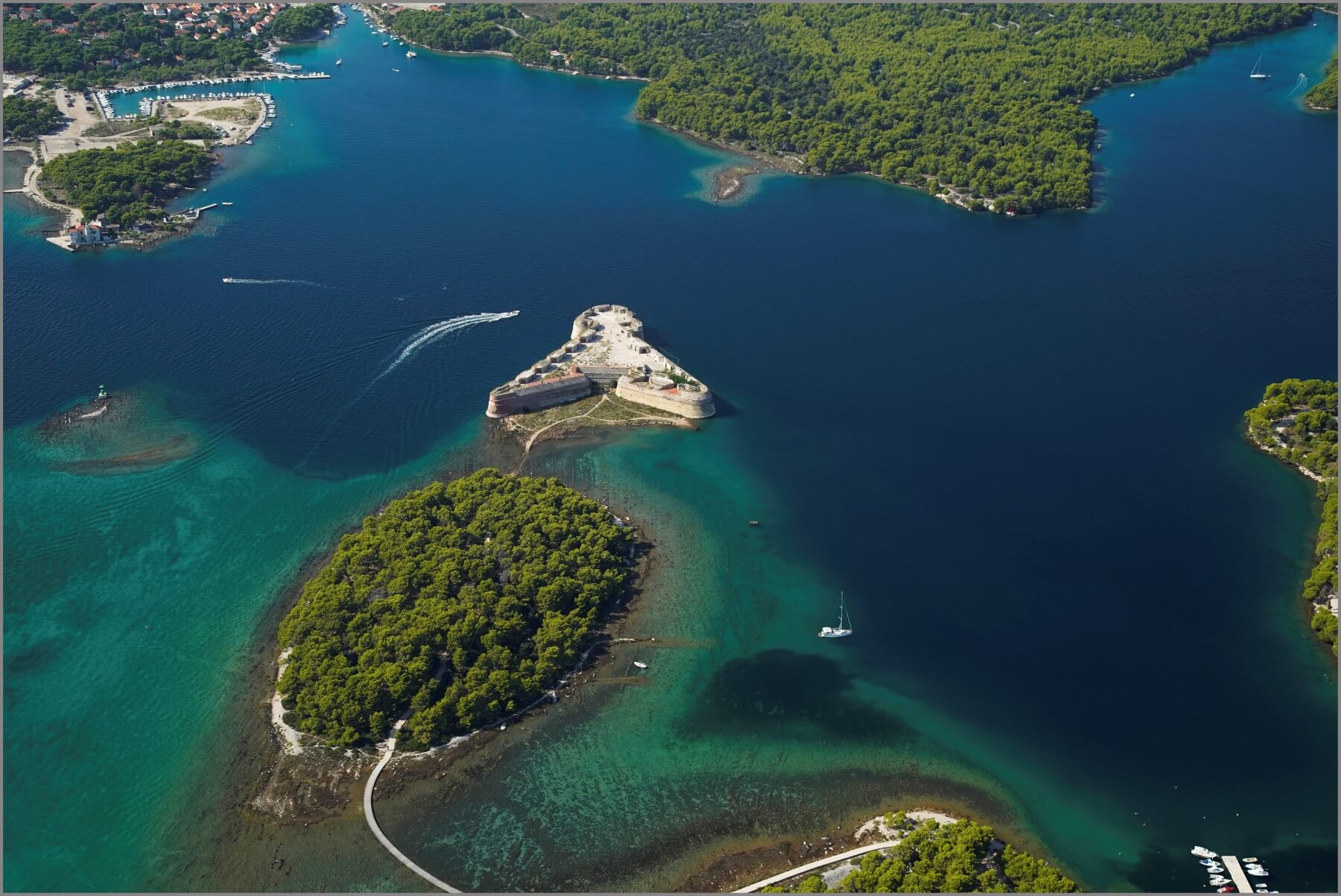 St Anthony's channel, St Nicholas Fortress and the cycle and walking path that reaches it via an island © Šibenik Tourist Board
St Anthony's channel, St Nicholas Fortress and the cycle and walking path that reaches it via an island © Šibenik Tourist Board
In the evenings, during their rest time, active Šibenik's guests have the city's best hotels, restaurants and charming Old Town almost to themselves. They share the cafe, bar and restaurant terraces only with Šibenik residents, relaxing once more now the city is returned to them.
Key to Šibenik's year-round appeal for fitness and sport fans is the city's unique landscape. No place in Croatia has natural assets like Šibenik. It is surrounded on all sides by a remarkable and startlingly varied topography.
Firstly, between Šibenik city harbour and the open Adriatic is a long waterway – St. Anthony's Channel. It is bordered on either side by two huge stretches of wild nature. Then, at the rear of the town, elevated up from sea level and next to Barone Fortress, the area of Šubićevac. Here, the entrance to the vast Šubićevac Forest Park, much of it an untamed, natural landscape. Thirdly, the vast Krka National Park, which lies just 10 kilometres north-east of Šibenik
Active Šibenik: St Anthony's Channel
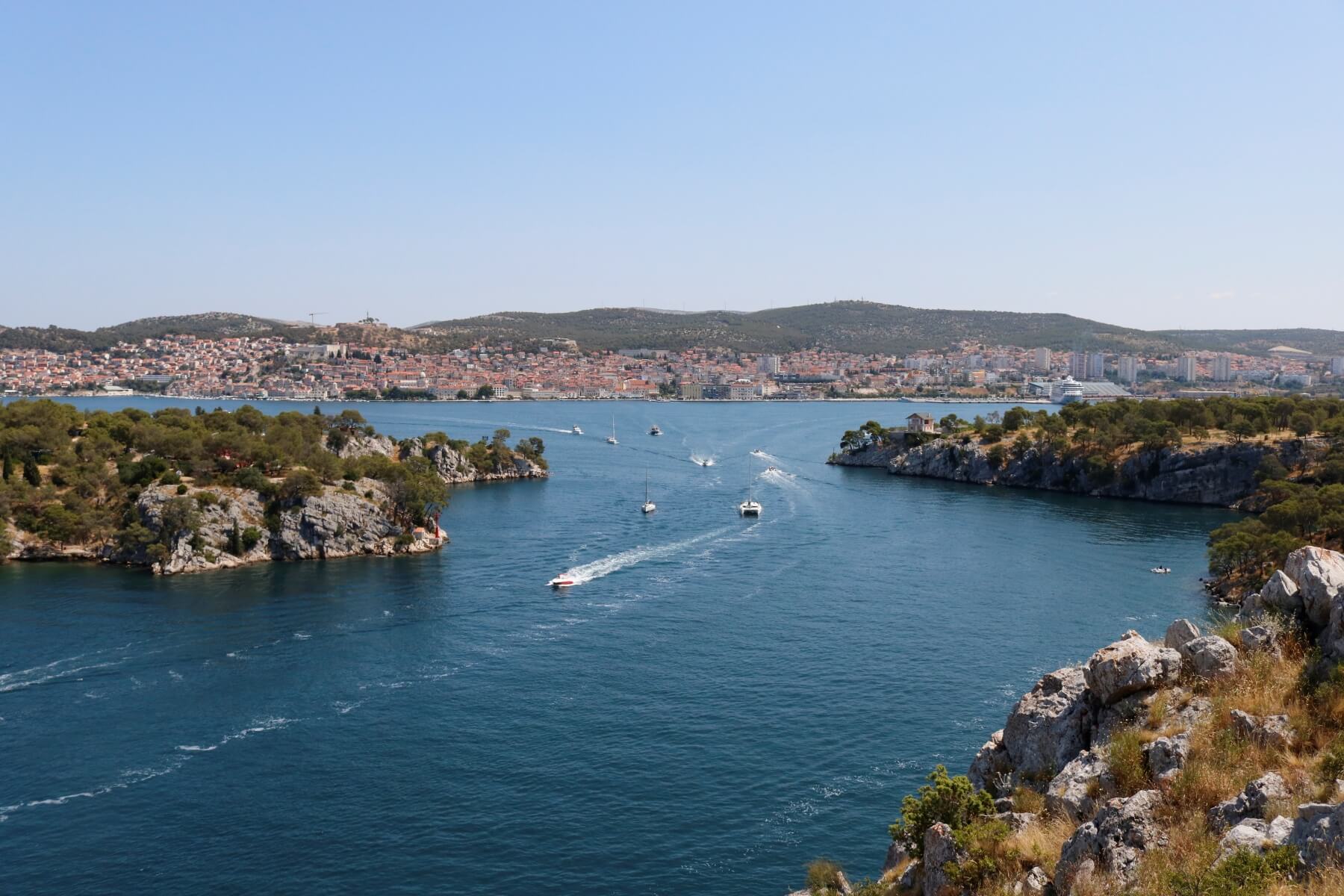
An epic 2000 metre long waterway, St Anthony's Channel is both a gateway to the open sea and the entrance to the city for anyone sailing into Šibenik. It is 140 – 220 metres wide and is bordered on each side by near untouched Dalmatian nature. On one side, sheer cliffs for one wall of the channel. At the top, dense pine forests, walking, hiking and cycling trails. Also, the famous recreation site of Martinska.
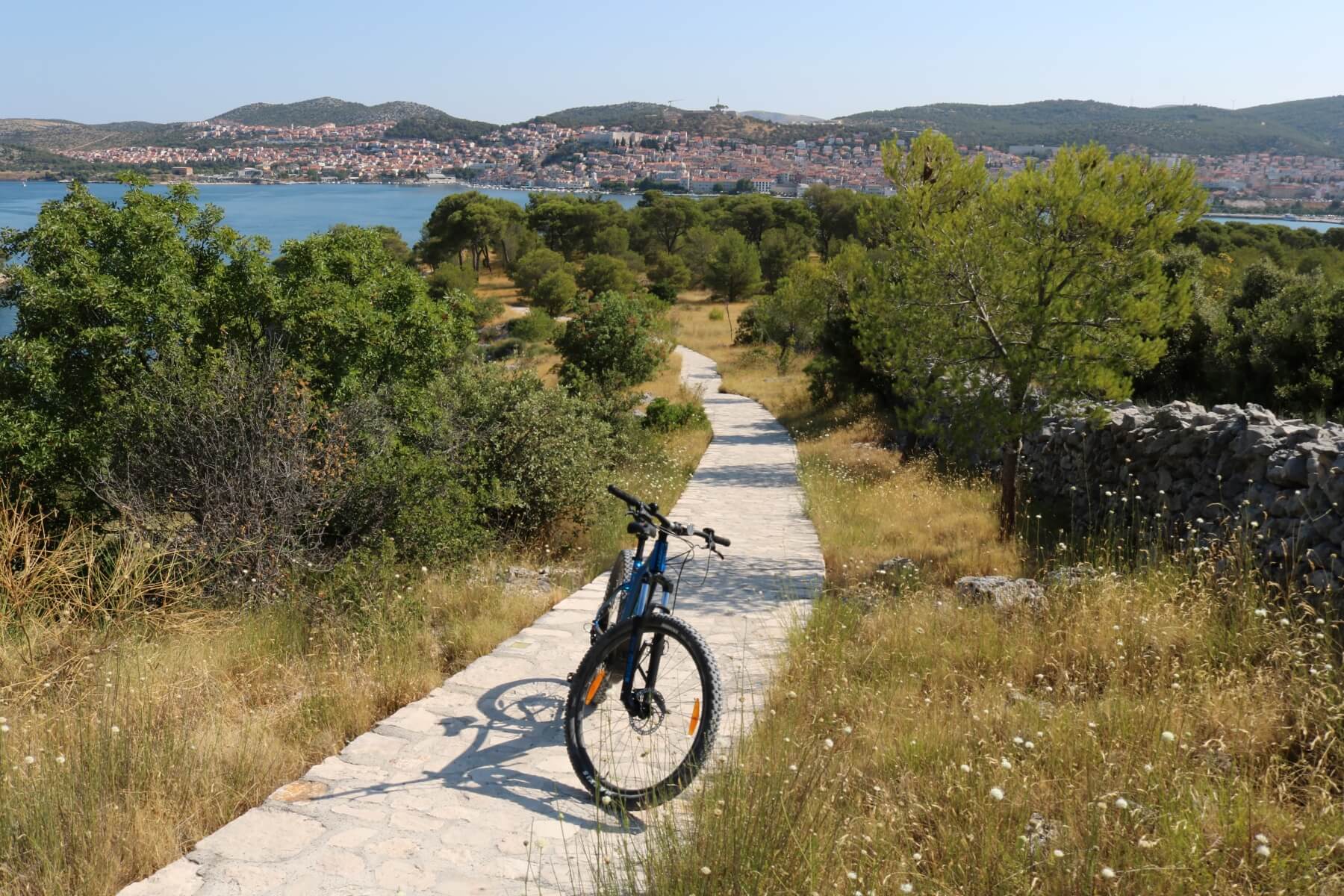
On the opposite side of the channel, a very different layout of the land. Here, the pines are much lower and closer to the channel. Between the two, idyllic beaches - the best in Šibenik – line a pathway designated for running, walking and cycling. Those on bicycles drop down from small hills on the interior. After following the path at the side of the water, their ultimate reward is the spectacular St Nicholas' Fortress. On both sides of St Anthony's Channel you'll see incredible views of Šibenik, its harbour and the side opposite.
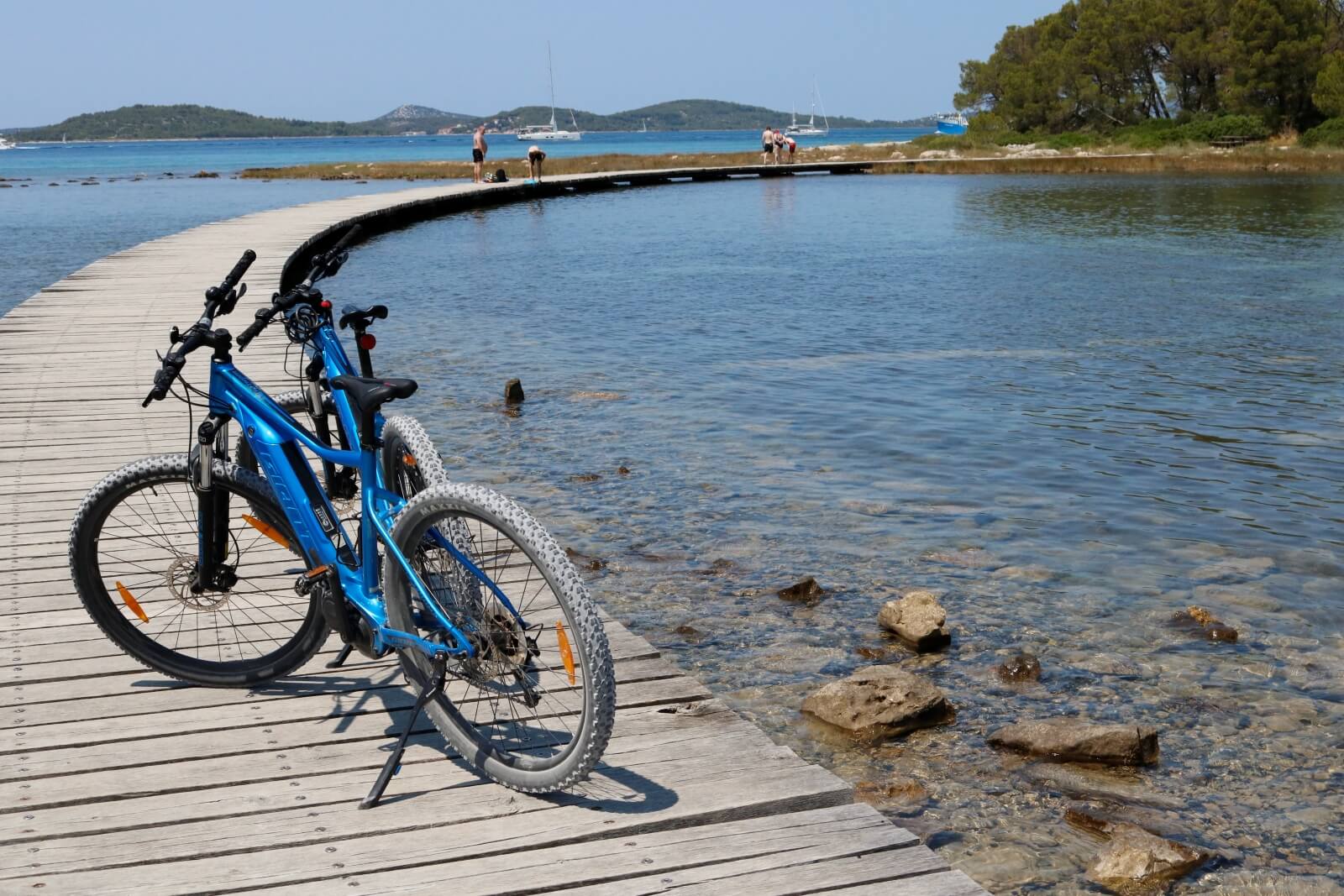
For those who prefer recreation on the water, St Anthony's Channel is perfect to explore by kayak. It's also one of the easiest ways to discover all of Šibenik's best beaches. Sticking close to the pine-sheltered coast, beautiful sailboats pass you in the centre of the channel, on their way to or from the city.
Active Šibenik: Šubićevac Forest Park
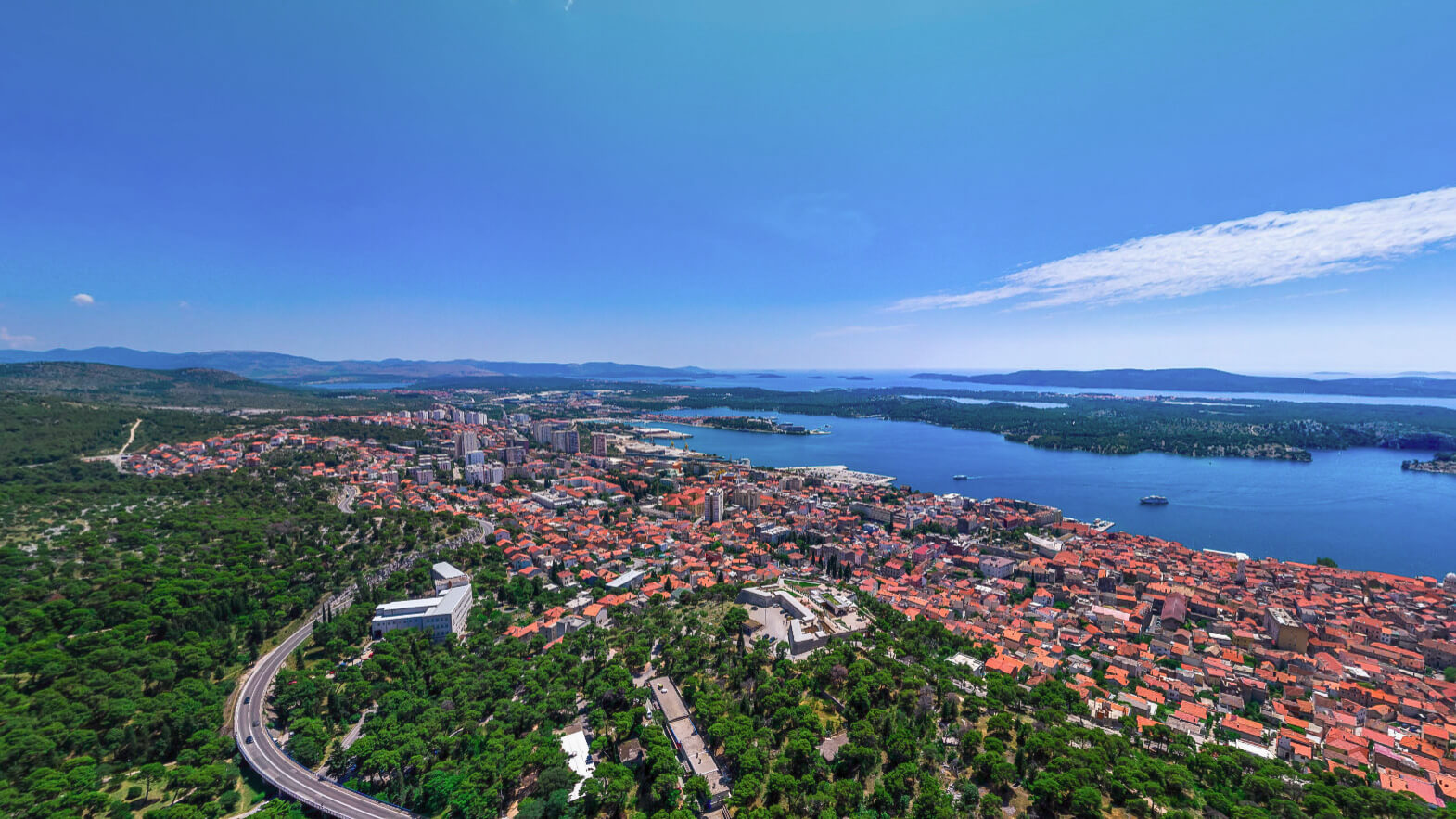 View over Šibenik, with Šubićevac Forest Park at the rear of the city © Šibenik Tourist Board
View over Šibenik, with Šubićevac Forest Park at the rear of the city © Šibenik Tourist Board
To visitors, Šubićevac Forest Park is the least famous of all Šibenik's recreational areas. A huge stretch of forestland, much loved by city residents, it rises above the city near Barone Fortress. The section of forest closest to the Šubićevac is designated as a city park. Within this part, you'll find a children's playground, specially designed to be accessible to all, including children with special needs.
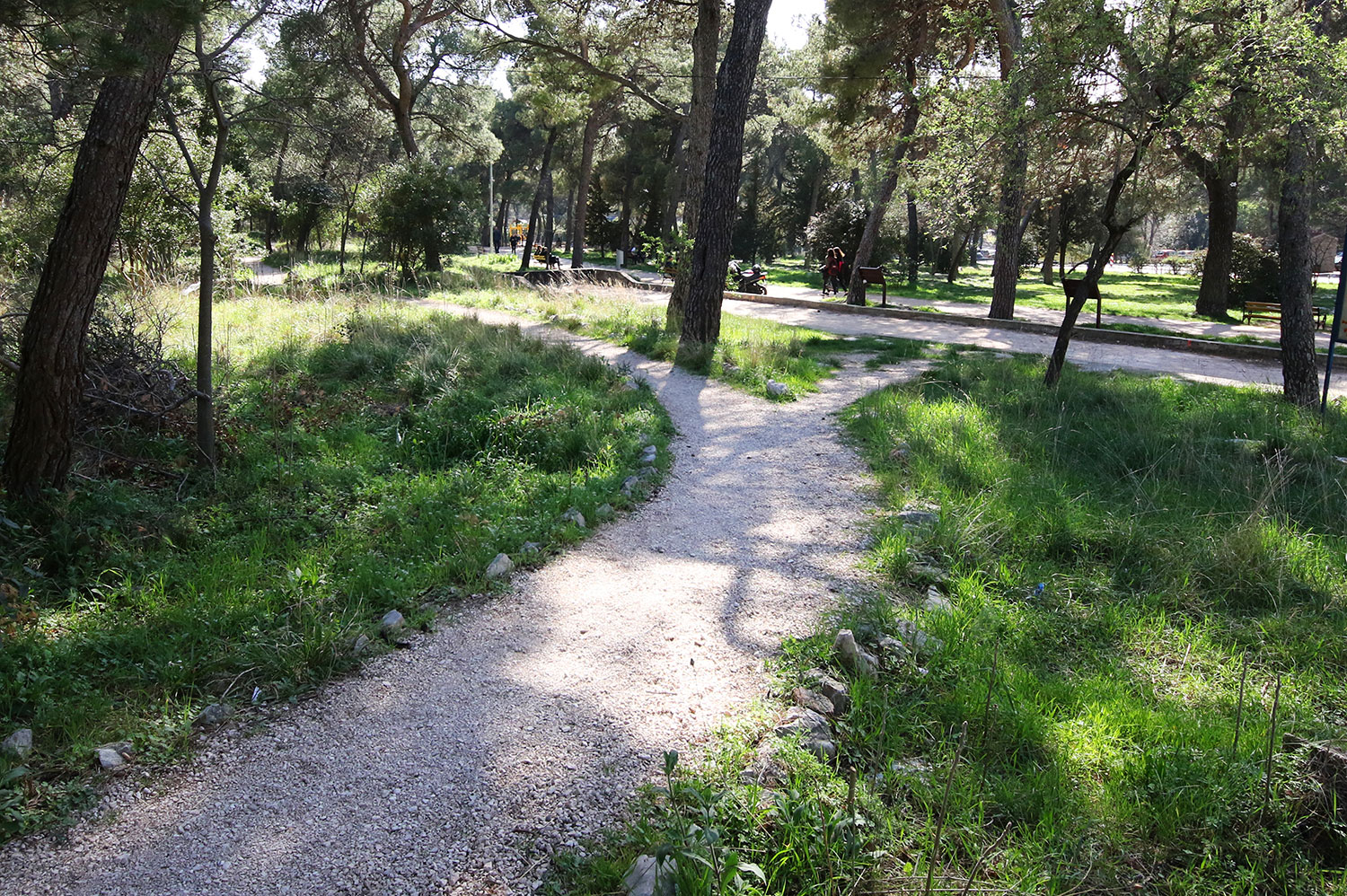 Easily accessible section of Šubićevac Forest Park © Javna ustanova Športski objekti Šibenik
Easily accessible section of Šubićevac Forest Park © Javna ustanova Športski objekti Šibenik
Throughout this section, designated paths for cycling and walking. Running to the southeast, a much larger area of near untouched forest. Here, a wilderness ripe for runners or hikers to explore. It's worth seeking out the tiny Church of St Michael here.
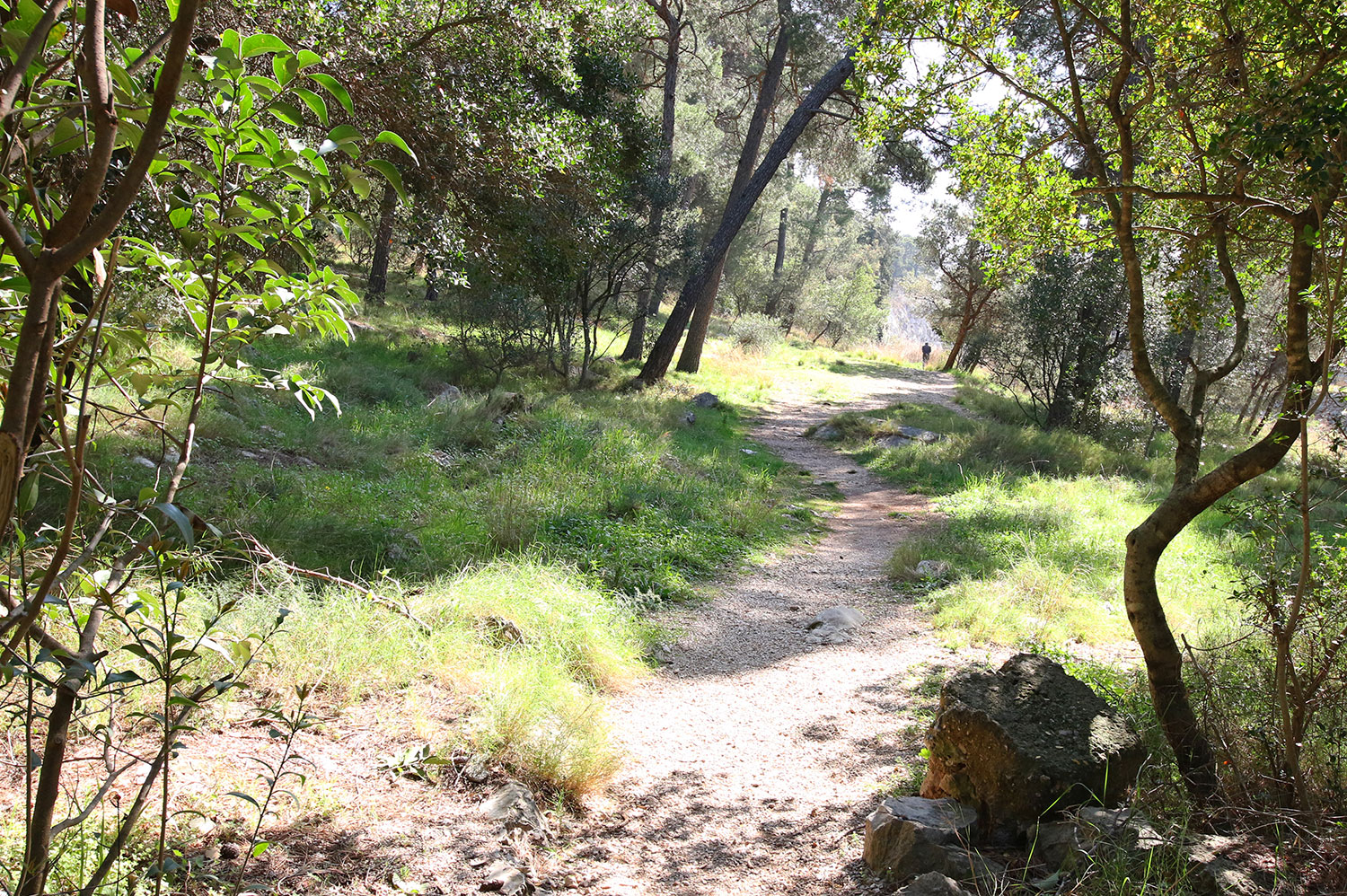 Paths through forest wilderness © Javna ustanova Športski objekti Šibenik
Paths through forest wilderness © Javna ustanova Športski objekti Šibenik
Residents say the very best views of Šibenik come from Šubićevac Forest Park. Certainly, they are breathtaking.
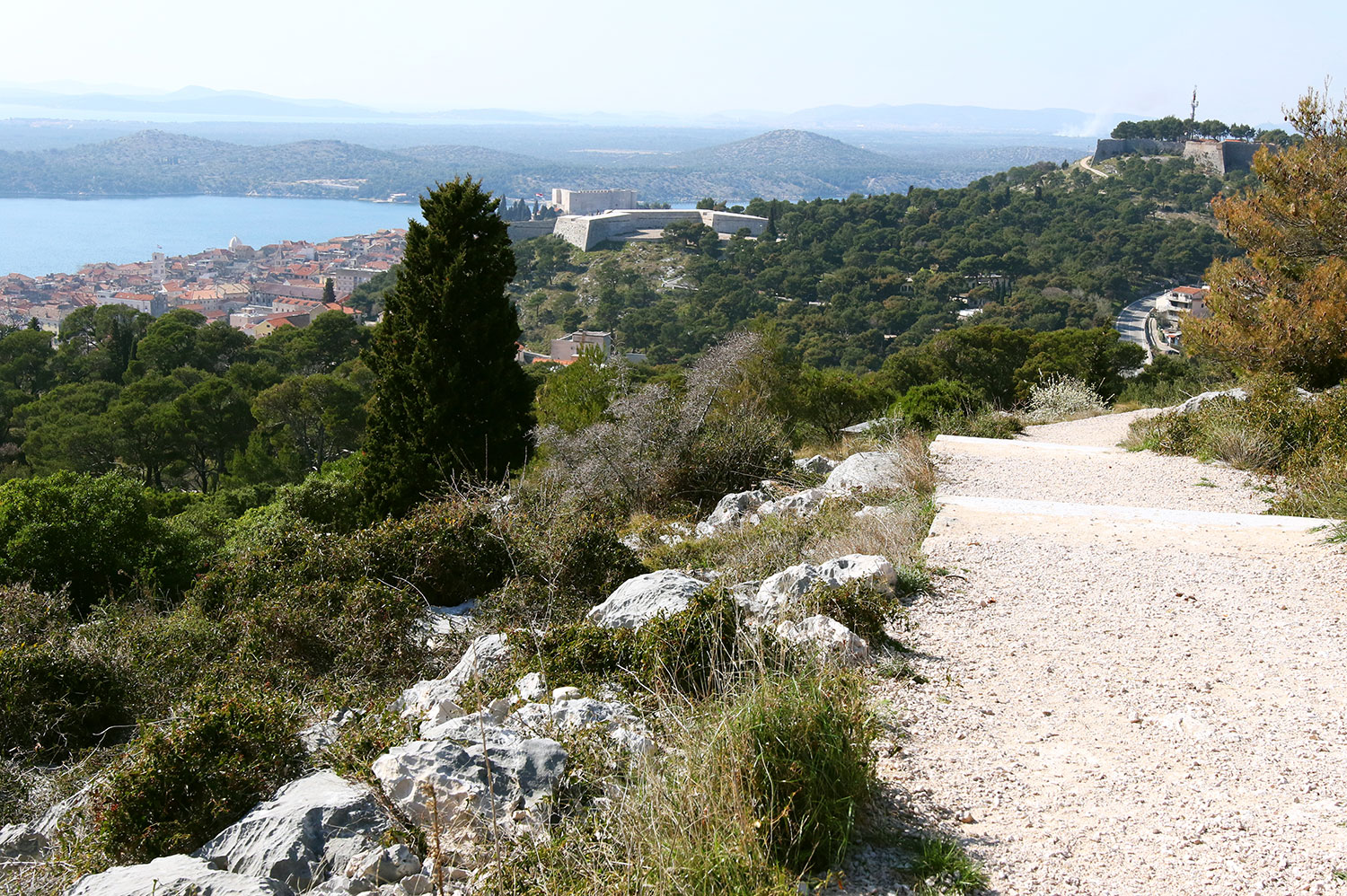 The best views over the city? It's a tough one to call - Šibenik has many contenders © Javna ustanova Športski objekti Šibenik
The best views over the city? It's a tough one to call - Šibenik has many contenders © Javna ustanova Športski objekti Šibenik
Active Šibenik: Krka National Park
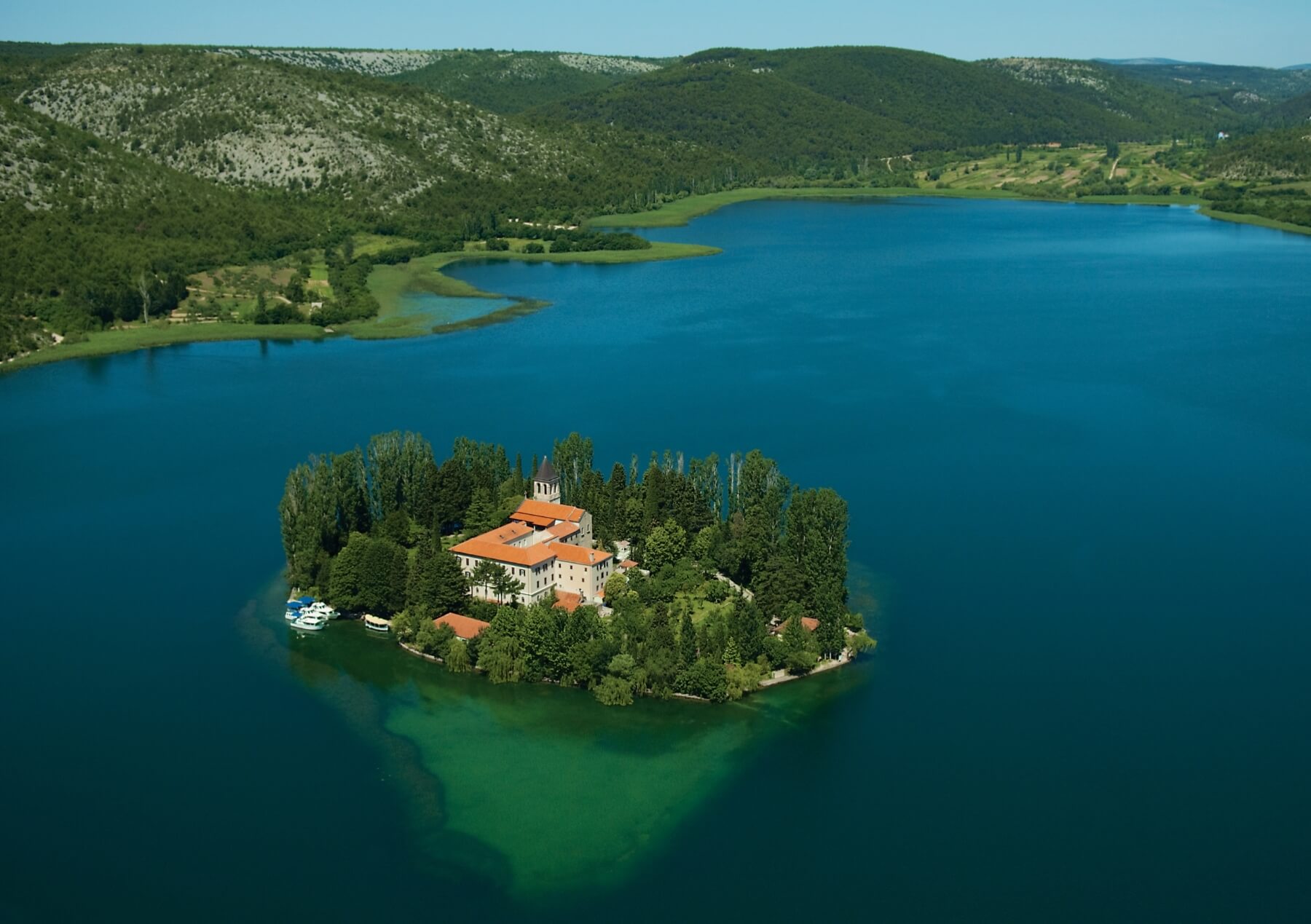 Island in Krka National Park © Šibenik Tourist Board
Island in Krka National Park © Šibenik Tourist Board
A series of wide pools, fed by cascading waterfalls, Krka is one of Croatia’s best known and most spectacular National Parks. Famous water features like the unforgettable Skradinski Buk dominate the park's postcard images. You'll find it near the park's most southerly entrance, very close to Šibenik. But, beyond this eye-catching introduction lies a further 109 square kilometers of spectacular National Park to discover. The best way to experience it is by walking, hiking or cycling.
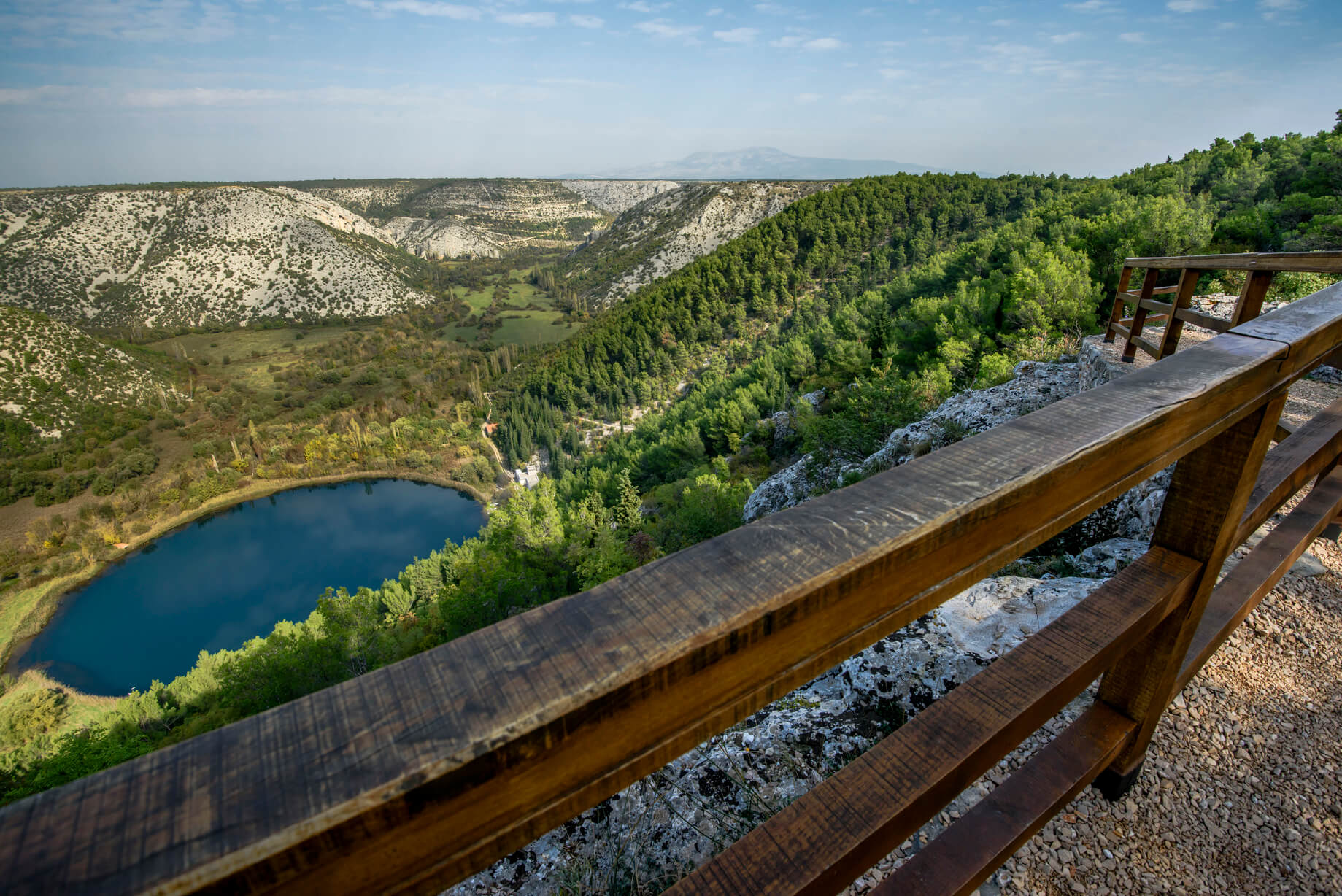 Countless captivating viewpoints © Krka National Park
Countless captivating viewpoints © Krka National Park
Hiking and walking trails of Krka National Park
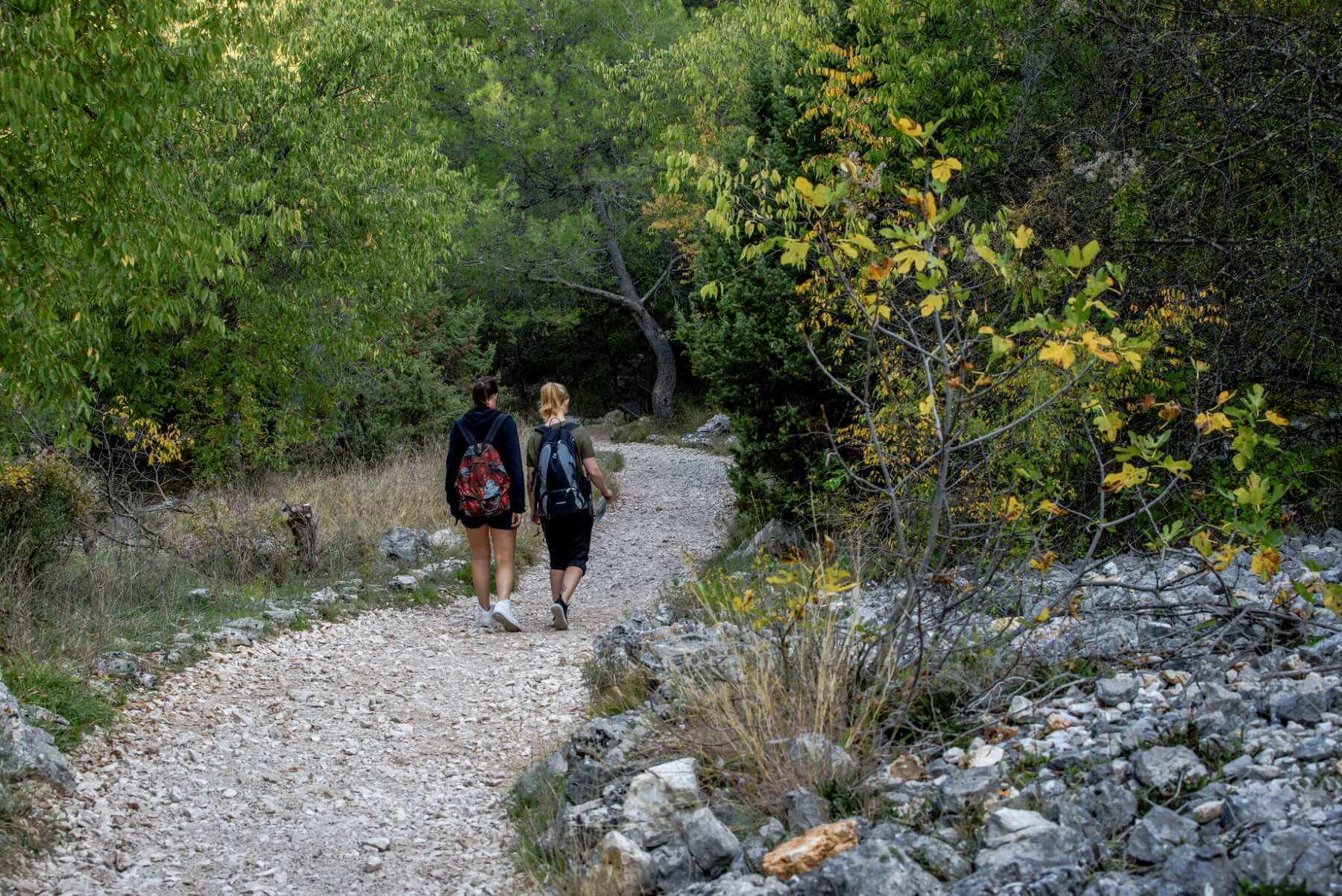 Walking and hiking trails © Krka National Park
Walking and hiking trails © Krka National Park
The park's hiking and walking trails give you the most thrilling views of this epic landscape and its wealth of flora and fauna. At the side of the trails, educational panels detailing the plants and animals you pass.
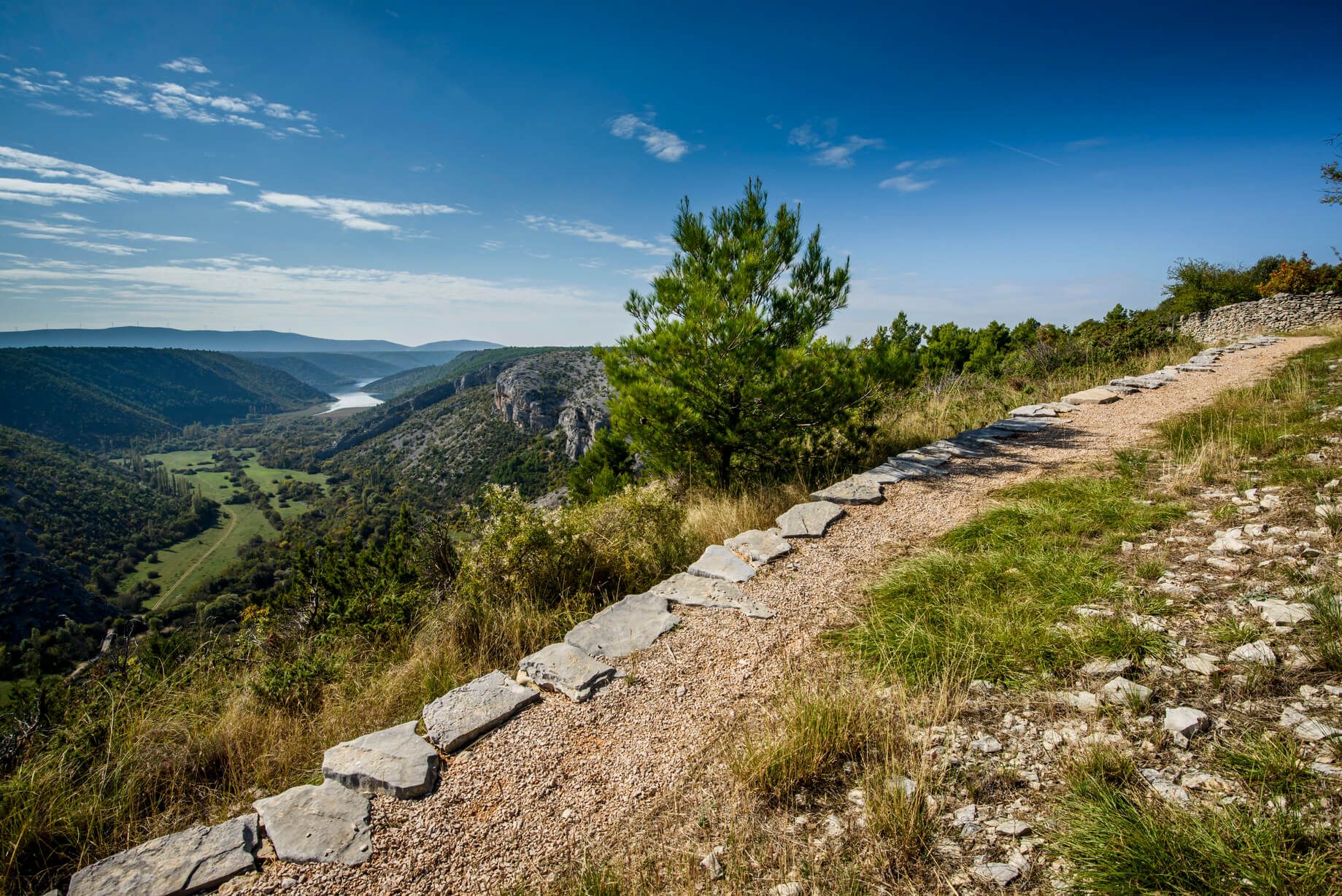 Epic landscape © Krka National Park
Epic landscape © Krka National Park
There are three circular trails: Skradinski buk (1900 m), Roški Slap (1360 m) and Krka Monastery (2100 m). A walking/cycling trail also leads to Skradinski buk from the Skradin bridge (3400 m), while from Lozovac, it is possible to take a forest trail (875 m) down to the park's longest waterfall.
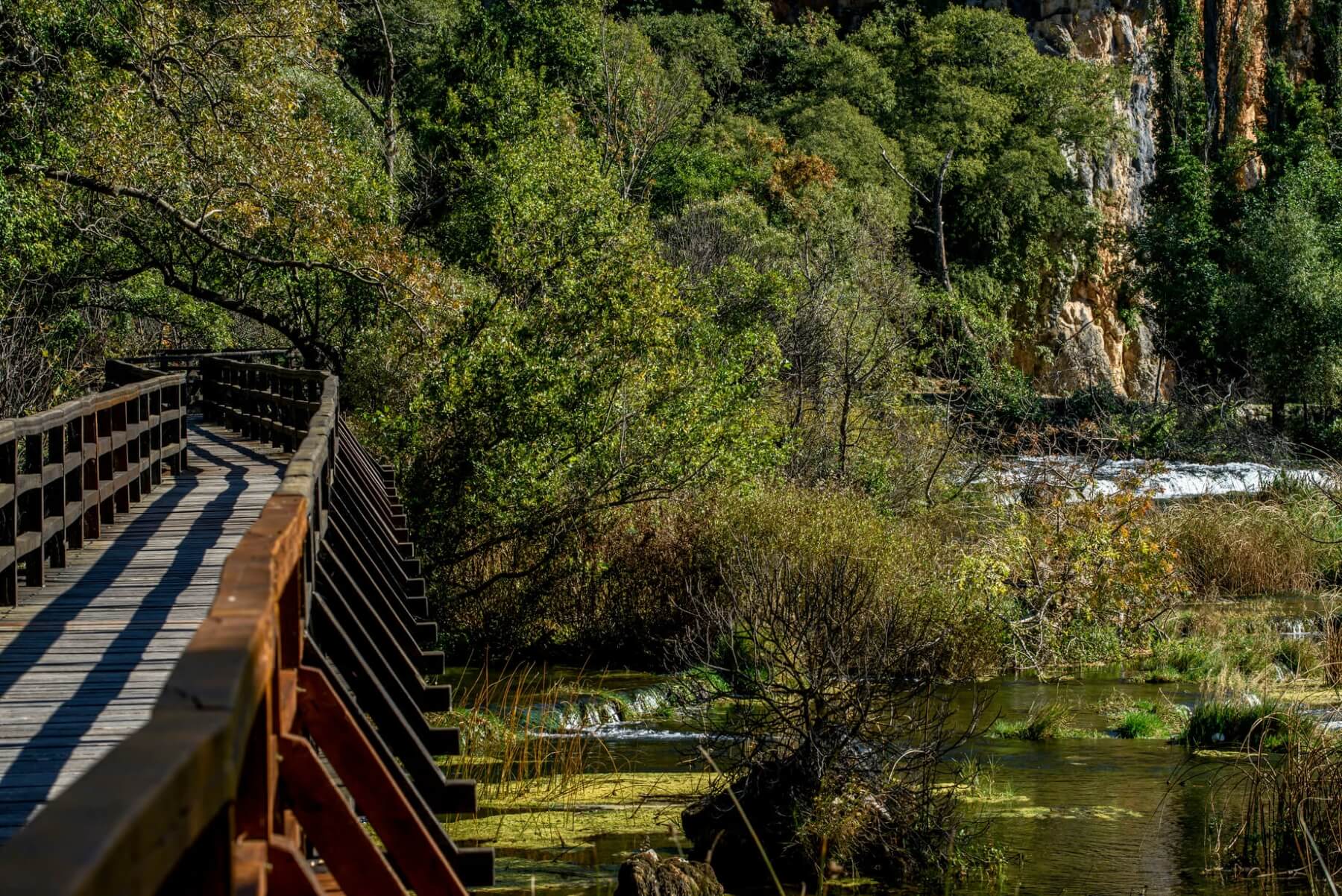 Walking over waterfalls © Krka National Park
Walking over waterfalls © Krka National Park
The shortest trail is 300 m long and leads to Bilušića buk, while the longest trail is Stinice-Roški slap-Oziđana pećina and covers 8.5 kilometres. In total, there are 7 spectacular waterfalls to find as the river Krka descends through the park.
Cycling routes of Krka National Park
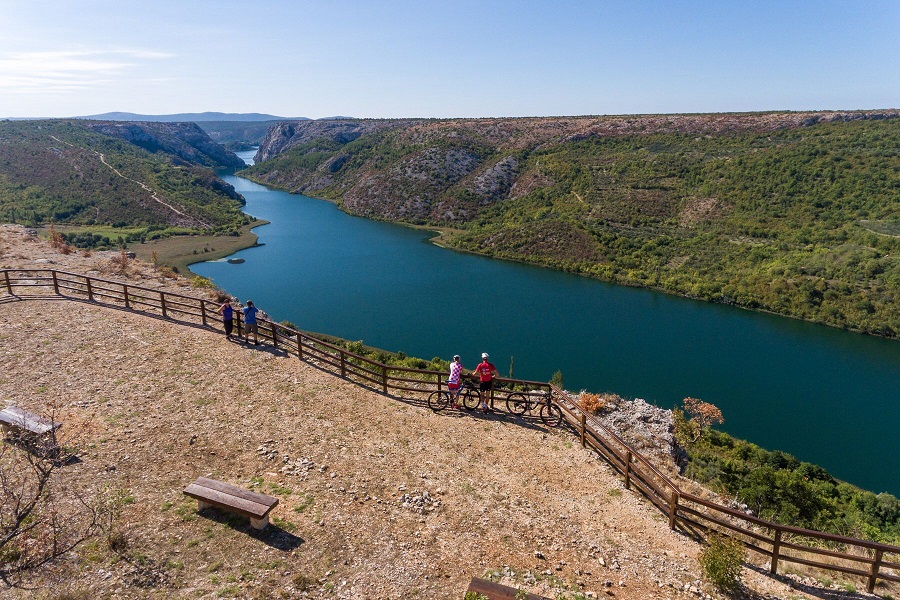 Breathtaking views on the cycling and walking routes © Krka National Park
Breathtaking views on the cycling and walking routes © Krka National Park
Bicycling through Krka National Park is a journey of endless enjoyment. If your perfect cycling route offers stunning landscapes, then this is the place for you. But, if you're curious to learn about the park's cultural and historical heritage, then cycling also helps you unlock these park secrets.
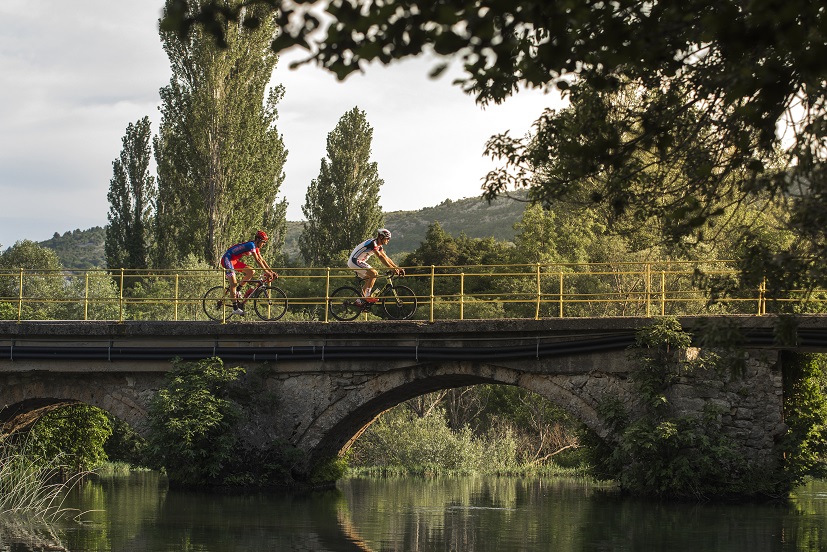 Cycling © Krka National Park
Cycling © Krka National Park
No less than fourteen cycling routes crisscross the park. They are divided into three types:
Road route - perfect for racing bikes and dedicated cyclists
Trekking & family route - a mixture of paved roads and gravel paths, perfect for city bikes, mountain bikes, families with children and cyclists of any age and ability.
Mountain biking route – a mixture of gravel paths and unarranged forest paths, with sharp ascents and descents, designed for mountain bike enthusiasts in good physical condition and with advanced cycling skills.
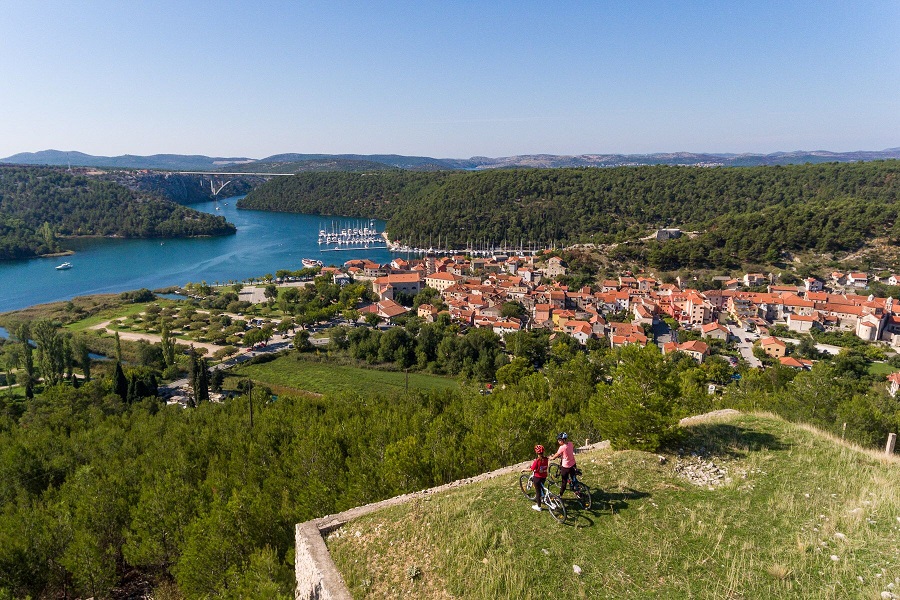 Cycling above Skradin © Krka National Park
Cycling above Skradin © Krka National Park
Šibenik zipline
On the northeast corner of the park, stretching across an epic canyon, one of Croatia's most thrilling ziplines. Flying from cliffs hundreds of metres above, so vast is the canyon that you can barely see the thrillseekers at the end of the first line. And, after that, there are still another two to go!
For more information and/or booking any of these activities, visit/contact Šibenik Tourist Board here
For more on great things to do in Šibenik, be sure to check Total Croatia News's dedicated pages here
Could Popular Croatian Highlander Become World's Number 1 Hiking Event?
September the 11th, 2021 - The Croatian Highlander brand has taken to many different countries and spread across continents, uniting lovers of hiking and ''tough fitness'' around the world. Is it set to potentially become the world's number one hiking event? Maybe.
As Poslovni Dnevnik/Ana Blaskovic writes, the first time you step out onto the peaks of Velebit, a magical mountain with a view of the endless greenery of the forests of Lika and the blue of the sea stretching all the way to neighbouring Italy, it's almost certain that you will descend from it as a different person. Enchanted by the mighty Velebit, a team from the very different Slavonian plains, led by Jurica Barac, became mountaineering enthusiasts whose story began as a local mountaineering adventure and became a global business.
Five years ago, Highlander Velebit was created, an adventure that combines the beauty and peace of this natural gem and the ultimate long-distance hiking experience. When this year's mountaineers leave Zavizan on September the 25th, in five days, they will pass 100 kilometres through the national parks of Northern Velebit and Paklenica, where the trail ends with a triumphant jump into the sea in Starigrad.
While ten years ago it was almost impossible to meet living souls on Zagreb's Medvednica except on weekends, today it is common to meet a group of mountaineers or cyclists on Wednesday evenings who are descend back down into the city below with lamps on their heads. A reversal in the way of thinking and the growing need to escape to nature after work is one of the main reasons for the success of the Croatian Highlander brand as well.
"The wellness market is set to blow up over the next five to ten years. Croatia hasn't yet fully tapped into its potential, but more and more people are starting to engage in sports and hiking,'' stated the executive director of the Croatian Highlander brand, Jurica Barac.
This is reflected in the applications for the upcoming Velebit adventure, the number of which is increasing from year to year, and these events could easily be attended by about 600 mountaineers.
Soon after it came to life, the Croatian Highlander brand transcended local and regional boundaries and today it is organised on 12 more mountains in Austria, Greece, Portugal, Bosnia and Herzegovina, Serbia, Montenegro, Slovenia, Northern Macedonia, but also Spain, Egypt, Morocco and the United Arab Emirates.
Global branding
"When the coronavirus pandemic started, we had a year of great expansion in which we sold the rights to the event in five more countries. Then for 2021 in ten more countries, mainly here in Europe and in the Middle East,'' explained Barac. It was, as he says, a trigger to start thinking about taking the next serious step - looking for a fund or bank to finance the expansion or a strategic partner.
The decision eventually fell on the world’s leading event brand, the American Spartan Race, who initiated contact with the Croatian Highlander brand and with whom a global strategic partnership was recently contracted. Spartan Race has otherwise been organising obstacle race events since back in 2010, meanwhile it has expanded its business to 45 countries and become a world leader in endurance sports, creating a new category of "Tough Fitness".
"When we started the talks, it wasn't really money that was all that crucial for us, but the possibility of global branding. It's very difficult and takes a long time to get to the US market, which is the ultimate market for us,'' said Barac. Spartan Race, whose events are attended by 1.5 million people per year, already has all these channels open and will be available to the Croatian Highlander brand.
Barac hasn't disclosed the investment and the amounts in question, justifying that with the fact that the figures are a trade secret, but he will only say that the majority control of the company is still in his hands.
Next year, the Croatian Highlander brand will organise three to five events in the USA, China and much closer to home in England, the exact locations are currently being discussed, but it is to be expected that they will be in some of the most famous national parks.
"It was crucial in the talks that Highlander will become the number one hiking event in the world with this cooperation. We're already negotiating with countries like Argentina, Australia and South Korea, we wouldn't be able to do that alone without a strategic partner,'' Barac said.
When it comes to tasting success, anyone who has tried their hand at business will say that a special mindset is needed. Much like in sports, the domination of the mind over the body is crucial. The old saying that luck favours the brave, or that God lovers one who tries, also rings true here.
Incredible luck appeared when the Croatian Highlander brand embarked on the intellectual protection of the brand in the USA and Europe, managing to protect the name Highlander, although in America, where about 40 million people are engaged in mountaineering, it is practically synonymous with mountaineering.
With the support of Spartan Race, the Croatian Highlander brand has an optimistic future and the aim to present its concept to a much wider audience, while keeping the concept and philosophy in the hands of the founders.
“Investing in a partnership with Highlander allows us to encourage even more people around the world to participate in physically demanding activities that they think are beyond their reach. We're excited to work with Highlander and increase their global reach, but also because of the fact that we'll be able to offer our Spartan community even more opportunities to step outside of their comfort zone,'' said Spartan Race founder and CEO Joe De Sen when the collaboration was agreed.
For the American company, the cooperation with this rising Croatian company is an opportunity to expand the "tough fitness" portfolio to hiking.
For more, follow Made in Croatia.
Croatian Hiking Festival to Take Place on 4–5 Sept
ZAGREB, 1 Sept, 2021- The Croatian Walking Festival, to start in Otočac this Saturday along the Gacka River and continue on Sunday in the area of Gospić, will be attended by 500 participants and no new applications will be accepted, the Lika-Senj County tourism board said on Wednesday.
Signs are being renewed along the hiking routes which are being checked so that there are no unexpected events along the way, the tourism board's president, Ivica Radošević, told Hina.
He added that 850 people had applied in all to participate, some of who have registered for both days. No more applications are being taken as the maximum number of participants a day has been restricted to 500, in line with epidemiological rules.
Most of the participants are from Croatia but there is also a significant number of visitors from Germany, USA, France, Norway, Slovenia and BiH.
Local family farms will offer their wares to walkers in Čovići, Prozor, Ličko Lešće and Sinac and then on Sunday in Smiljan, Debelo Brdo, Bužim and Žabica.
Croatia's Walking Festival has this year become a candidate for the IML International Walking Association and an IML inspector from France will be overseeing the 4-5 September hike.
For more on lifestyle, follow TCN's dedicated page.
For more about Croatia, CLICK HERE.
Pelješac Interactive Map with Cycling and Hiking Routes Available
May 26, 2021 - As part of an effort to strengthen adventure tourism on the peninsula, a Pelješac interactive map is available with five circular mountain biking routes and six hiking routes.
As stated by turistickeprice.hr, tourist communities from Pelješac united at the end of last year to develop tourist products of Pelješac. Specifically, they approached the development of outdoor offers through hiking, cycling, and windsurfing, and five thematic festivals are planned in which visitors would enjoy the flavors of Pelješac, traditional dishes, and the well-known Pelješac wine.
As part of the development of the Outdoor Program, an interactive map of mountain cycling and hiking routes in Pelješac was made. There are currently five circular mountain cycling and six hiking routes on the map. Additional route extensions are planned, as well as the addition of catering facilities and wineries to the map so that guests can easily find their way around the area and get to know the complete offer of Pelješac. Pelješac is rich in wineries and traditional taverns and restaurants, so the combination of outdoors and traditional flavors is quite natural.
On the map, you can see information about the difficulty of the route, the type of surface, description, photos and you can download the GPX track that can be used in various mobile applications and smartwatches. There is also a link to the OsmAnd mobile app on the map, as a suggestion. Otherwise, the app is free to download and works offline.
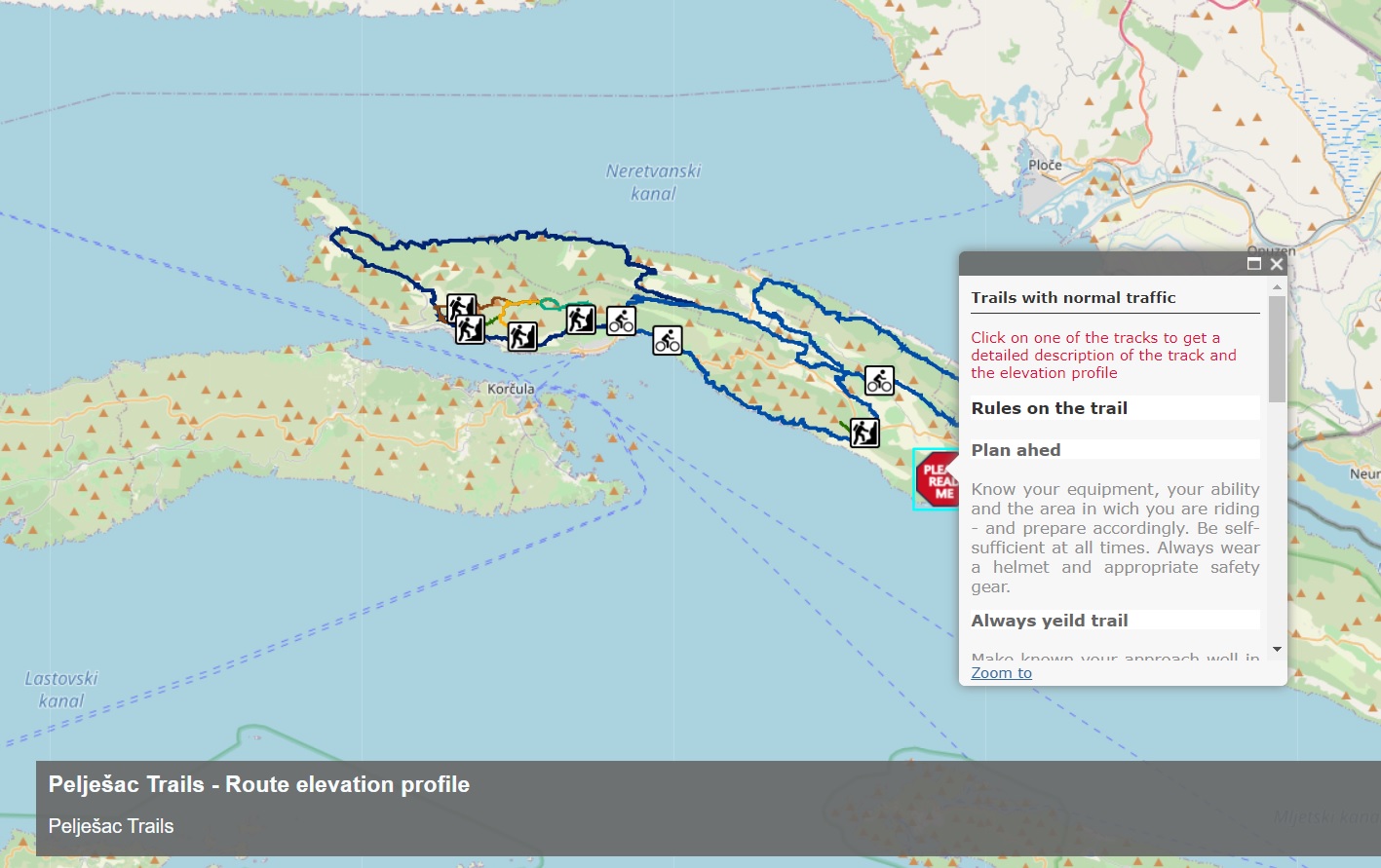
Pelješac Interactive Map with Cycling and Hiking Trails (Screenshot)
The map shows a total of five mountain bike circular routes with a length of 184 km and six hiking routes with a total length of 39 km. The Tourist Boards of Ston, Janjina, Trpanj, and Orebić note that they have developed an interactive map that cyclists and mountaineers can study without coming to the info center, or looking at the websites of tourist boards. In addition, the trails were made in collaboration with local cyclists who know the terrain best, and thus end-users will be able to discover the most interesting parts of Peljesac, which hides many natural beauties.
You can find the English version of the interactive map of Pelješac HERE, and the Croatian version HERE.
You can learn everything about what the Pelješac peninsula can offer you on your next trip, in Total Croatia’s Pelješac peninsula on a page, HERE. Total Croatia’s articles are now available in your language!
For more information about cycling in Croatia, go to Total Croatia's dedicated page.
For more on travel in Croatia, follow TCN's dedicated page.
Croatian Couple Completed Via Adriatica Trail in 54 Days, Liked Dinara Most
February 24, 2021 – TCN recently interviewed Josipa and Matija on their 1,100 kilometers long journey, and now this Croatian couple completed the Via Adriatica trail with success... but not without the headache of the demanding Croatian mountain regions and changeable and unpredictable weather conditions.
Josipa and Matija set off on the Via Adriatica trail on January 1, 2021, starting from Prevlaka, the southermost peninsula in Croatia. The last time we talked to them was one month ago when they were at Svilaja mountain, not even half of their journey. Yesterday, after 54 sunny, rainy, snowy, foggy, and windy days, this Croatian couple completed the Via Adriatica trail.
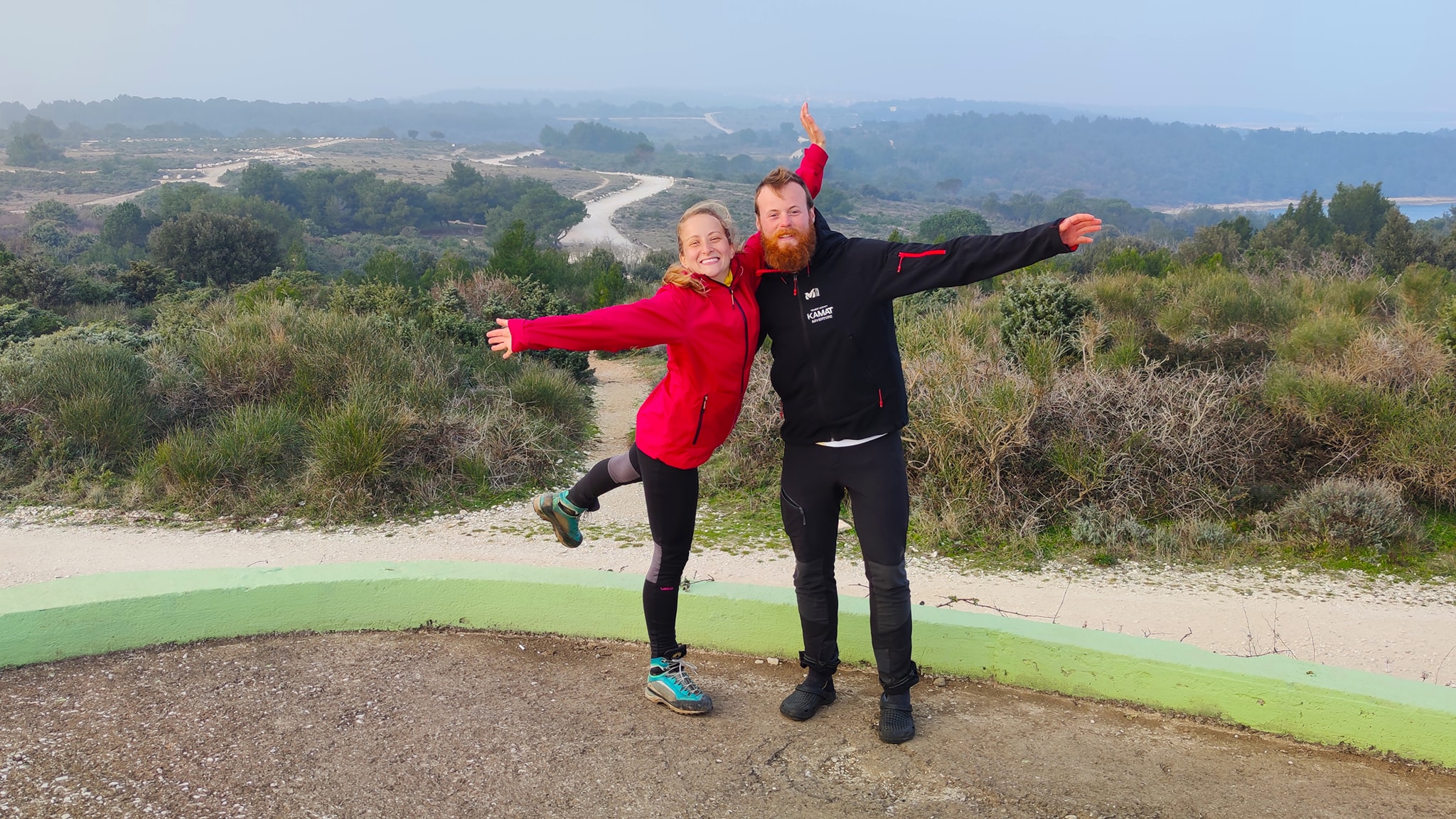
In the meantime, the Dinara mountain, a newly declared Croatian 12th National Park, amazed them the most, while Velebit mountain showed all of its natural power and broke them with snowstorms. However, after successfully overcoming all the climbs, peaks, sections, weather troubles, they finished their journey at Cape Kamenjak in Istria.
Lost in a minefield
Since Svilaja mountain, when we last heard from each other, the weather conditions created many problems for Josipa and Matija. First, due to the heavy rain, they could not move from the shelter for three days, and the weather forecast was getting worse and worse. They had to move on because there was no point in waiting anymore.
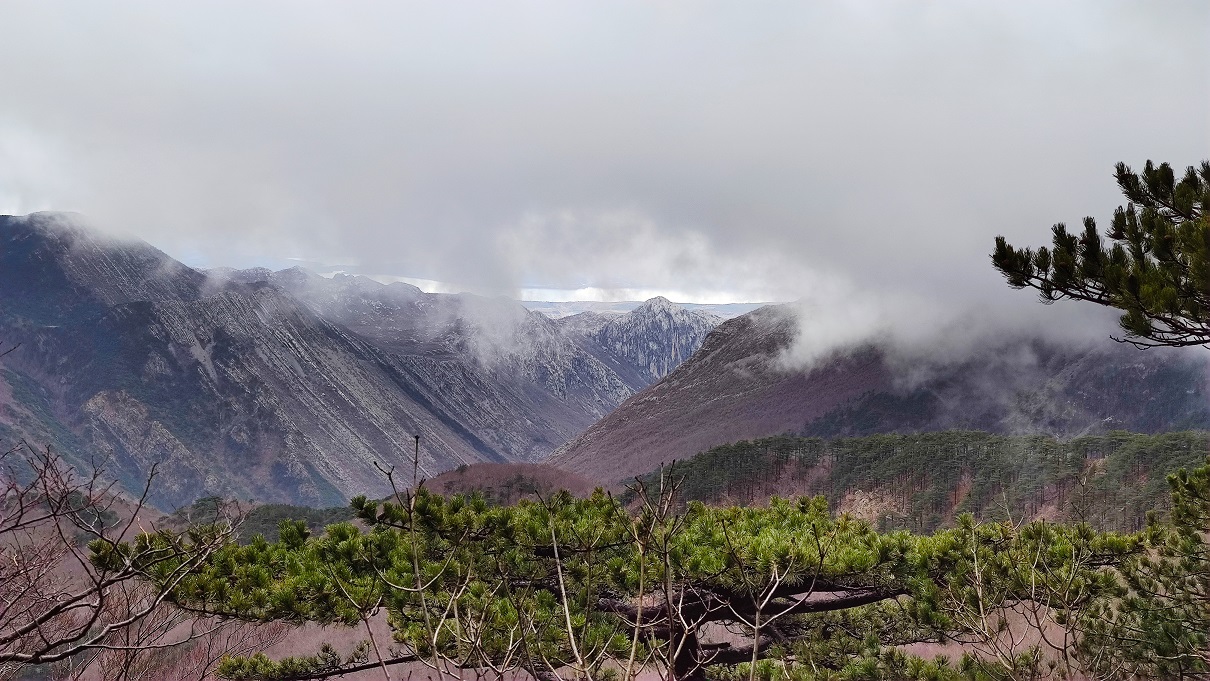
On the Dinara mountain, on the way to a shelter called "Vjetre s Dinare" ("Wind from Dinara" meaning Croatian stormy wind bura), they went through the fog, rain, icy rain, wind, and finally – through a minefield.
"We followed the markings, which at one point got lost because there was snow. It was a thick fog. We didn't see anything; the GPS didn't work either. So we went on our own about 200 meters. We saw a board in the distance, turned backward on us. We thought we would see something written on it, some marking! We climbed up, turned, and looked – 'caution, minefield, please don't pass this way.' I can't describe how we felt at that moment, without a trace, in the middle of nowhere. Besides, we were followed by a dog, a Turkish Kangal, which normally eats wolves," describes Josipa the moment when her whole life passed before her eyes.
Still, they somehow managed to get to that "Wind from Dinara" shelter, apparently so named for a reason. However, that's where another struggle started – lighting a fire.
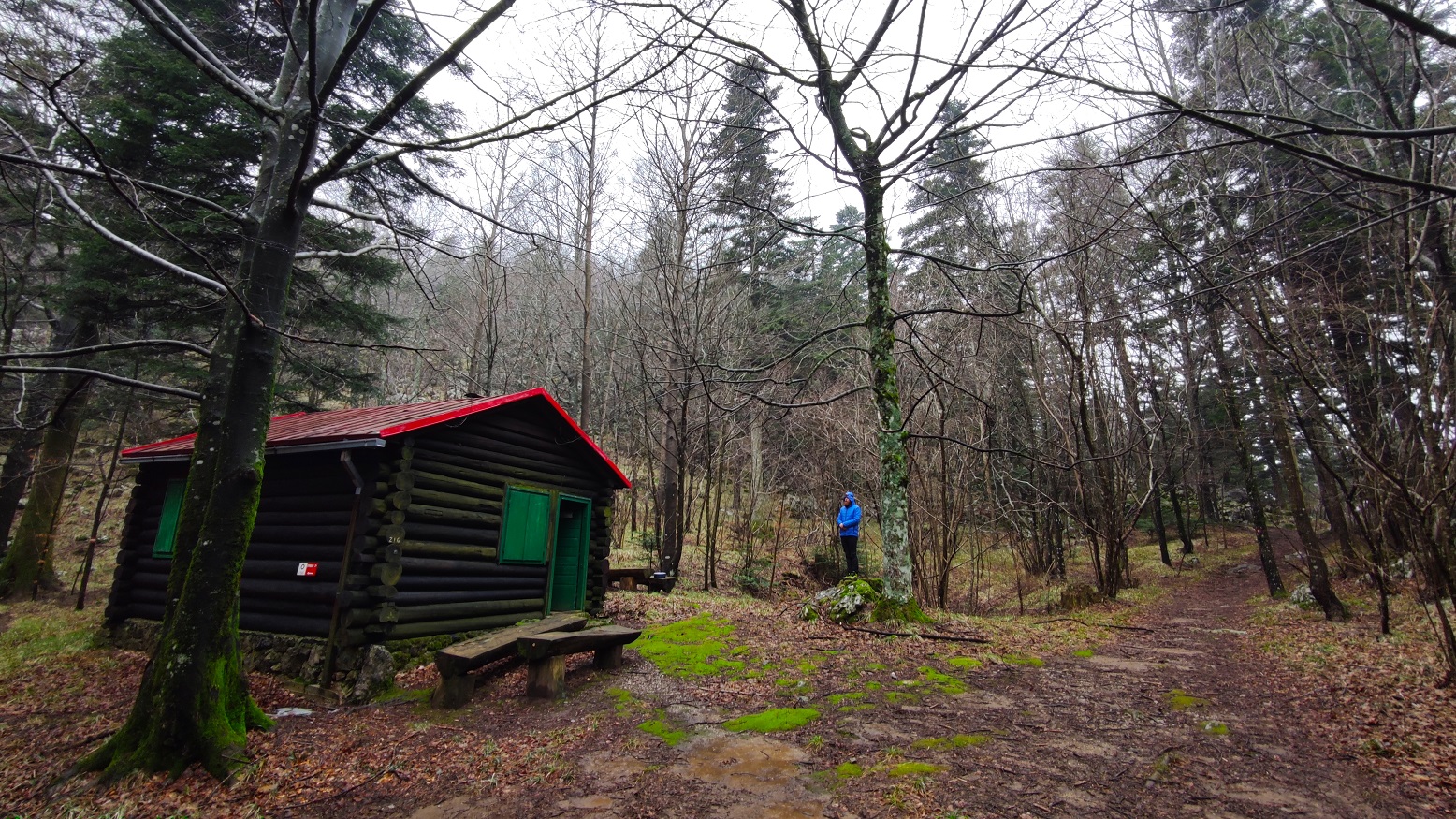
Real Himalayan conditions on Dinara
All the wood was wet, and Matthias struggled to light the stove. Due to the rain falling for the previous three days and over which the snow was falling, their boots were completely wet. Wood splitting and lighting a fire caused them many problems on the way, which, they admit, took a lot of energy and nerves.
"This whole heating situation was forcing us day after day to pick up bags and warm-up, so we went to bed around 7 pm every day," says Josipa.
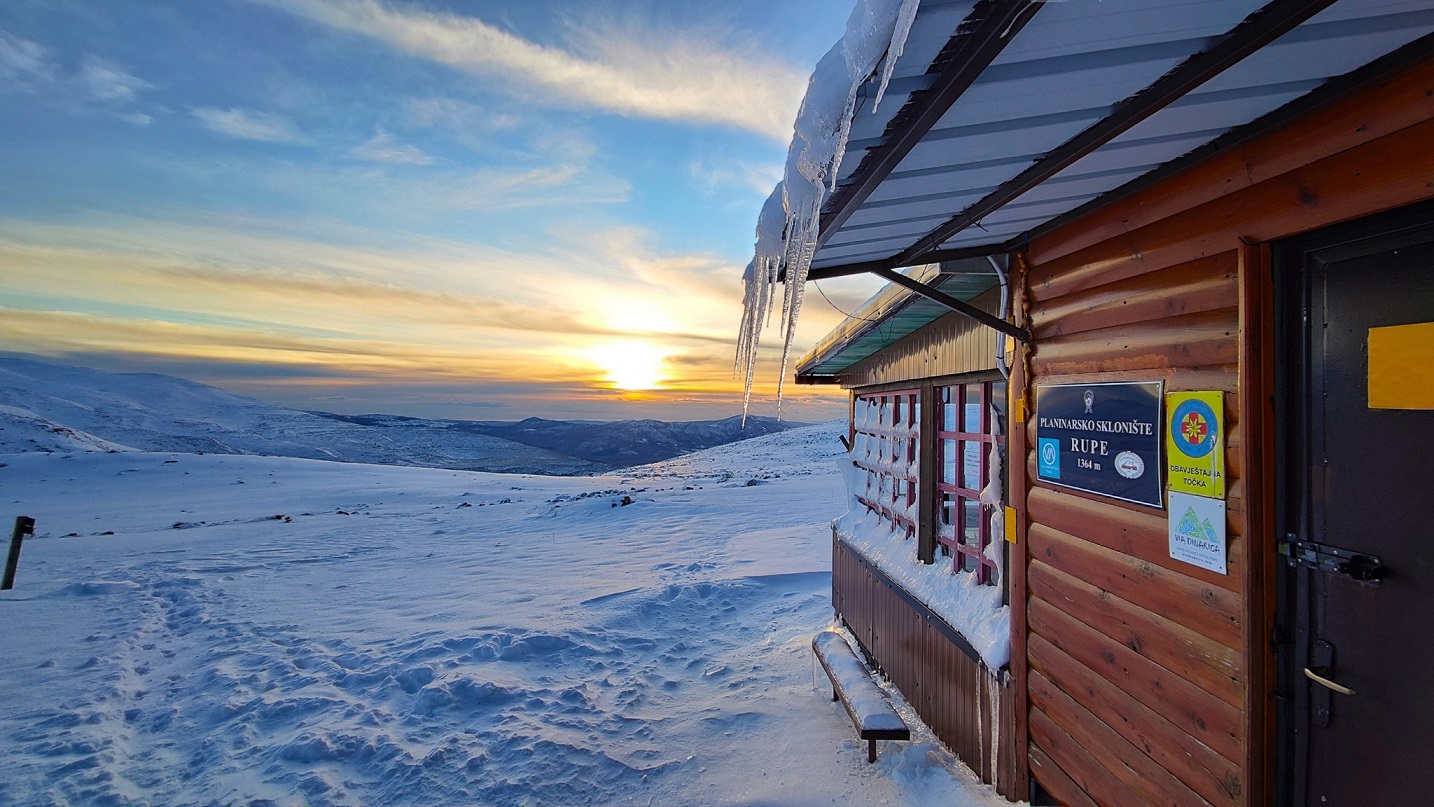
Mountain lodging Rupe on Dinara
On Dinara, they felt the power of the bura wind for the first time, which even extinguished the fire during one night in the shelter. All the smoke entered the small house, and all attempts to ignite the stove failed.
"It was freezing, minus 10 degrees Celsius, and the feeling reached minus 20 degrees with 110 km/h of gusts of wind. We experienced real Himalayan conditions on the Dinara," says Josipa.
Fortunately, they had warm sleeping bags with them – that were even too hot! Josipa and Matija couldn't believe that they were lying in a room while it's minus degrees while being hot in feathered bags. That's what it means for a mountaineer to have the right equipment. Still, they took advantage of those windy days to take photos and enjoy.
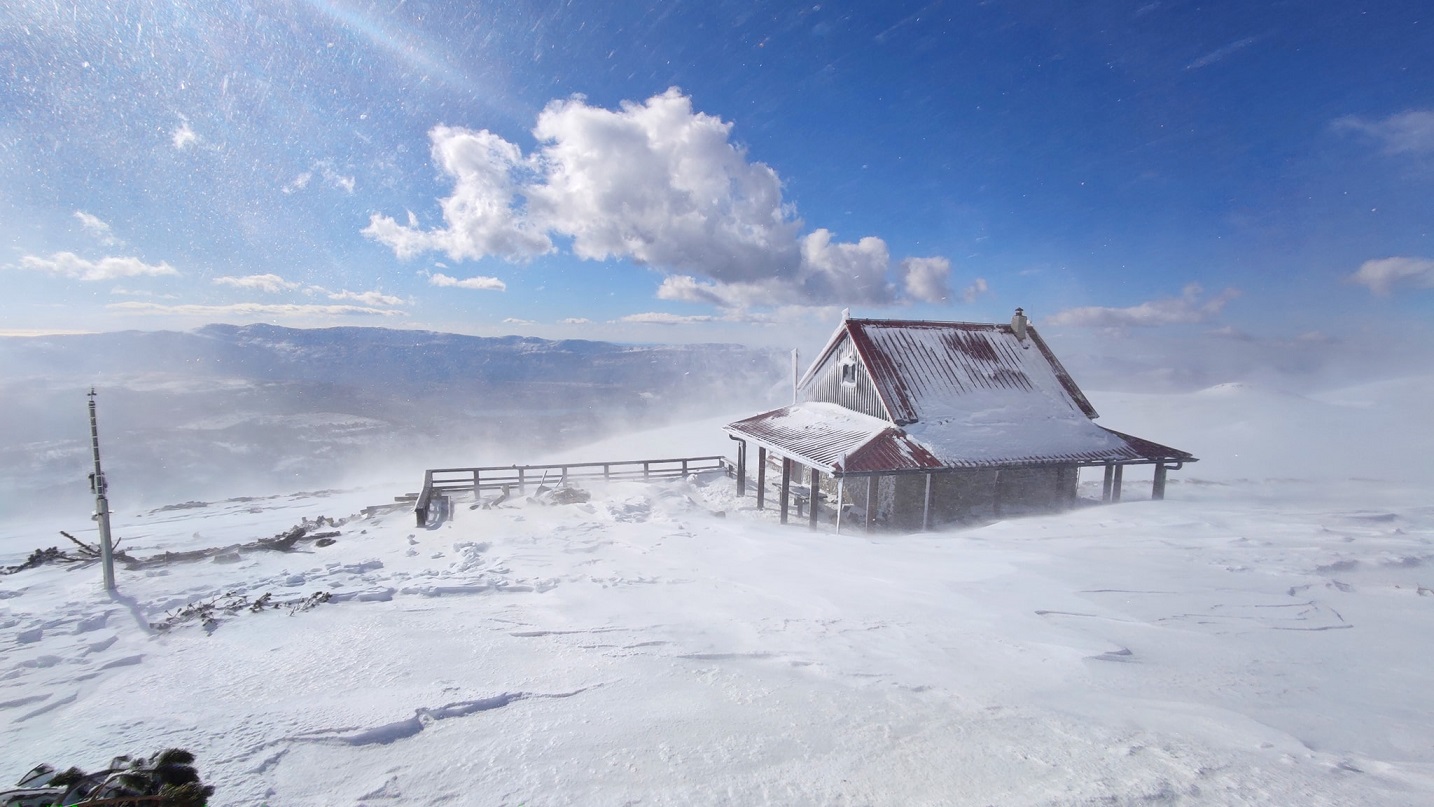
Mountain lodging Pume on Dinara
In the end, they had to leave the shelter and, despite a strong bura wind on which was difficult even to stand, let alone walk, they moved on. As the sun always comes after a storm, the weather finally calmed down, and it was beautiful.
Dinara – idyllic, fascinating, special, spacious, beautiful
The path towards Lišanjski Peak, the highest peak of the southern Dinara, they say, is a magical place that cannot be described but must be experienced. It is also the furthest point from civilization on the entire route.
"You are in the middle of nowhere. There is nothing in sight, no city, no roads, and everything around you is white. Everything is full of white peaks and hills. Idyllic. If someone threw me here and asked where I was, I would certainly not say that I was in Croatia," says Josipa.
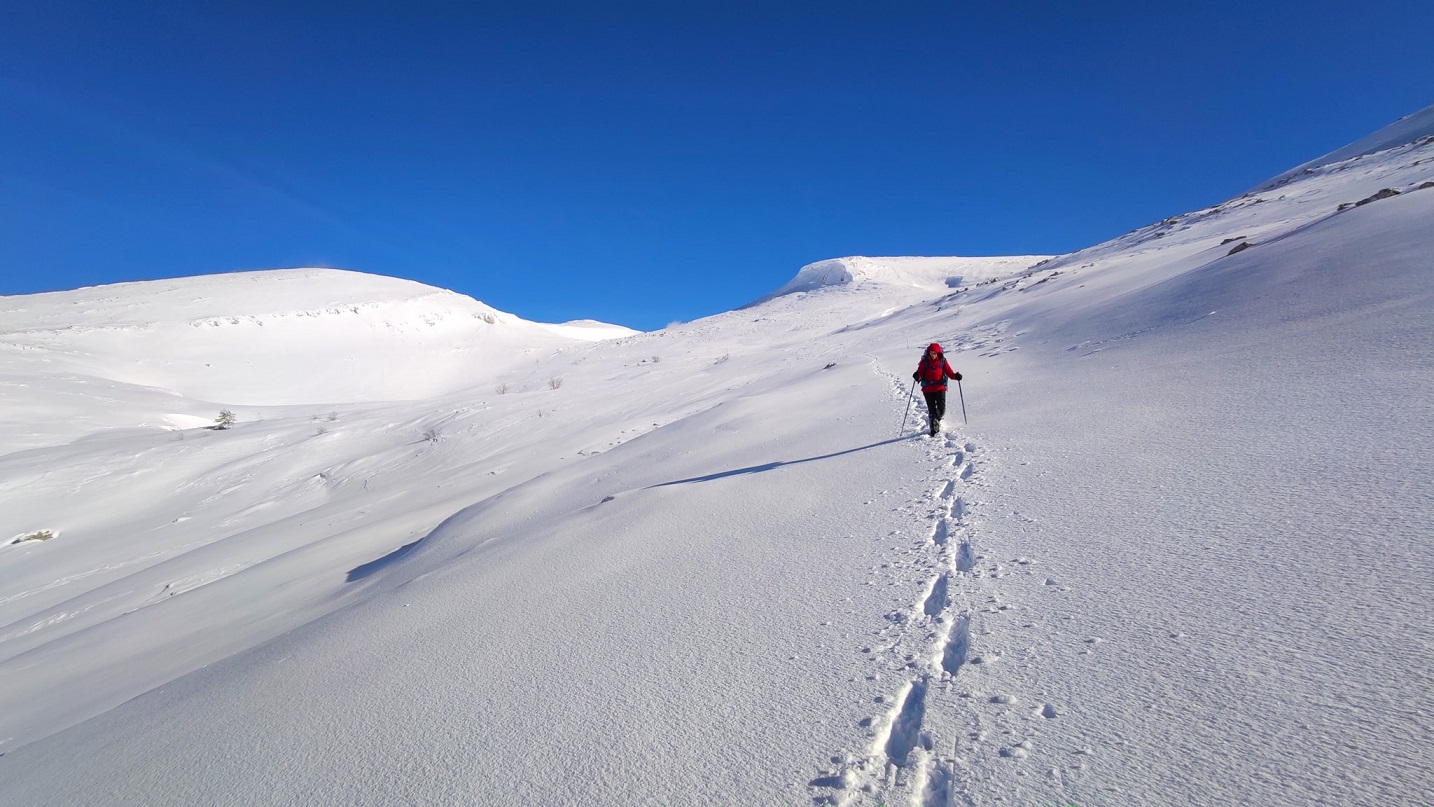
Josipa on Dinara

Matija on Dinara
And Lišanjski Peak itself is fascinating – you can see Bosnia, Dinara, the Cetina River source. In those hours and 15 minutes of climbing, they saw many fresh traces of bears, but (fortunately) no bear jumped out in front of them.
That part of the trip was the most beautiful, they agree. The weather was good. They even walked in short sleeves, though the snow had not yet completely melted. This incredible experience will remain in their memory forever. And when they descended to the source of the Cetina, Lišanjski Peak seemed so far away. An exceptional experience, unique energy, and a special ambiance, they say.

The source of Cetina River
For Sinjal, the highest peak of Dinara and Croatia, they have no words. Now that they saw it under the snow, it seemed ten times more magical than in September when they first experienced it.
"We were standing up at the top, watching, and we couldn't believe where we had come. On one side, you see Biokovo that we passed. On the other side, you see Velebit that's waiting for us. We were proud of each other and ourselves. I get little chills when I think of that part," admits Josipa.
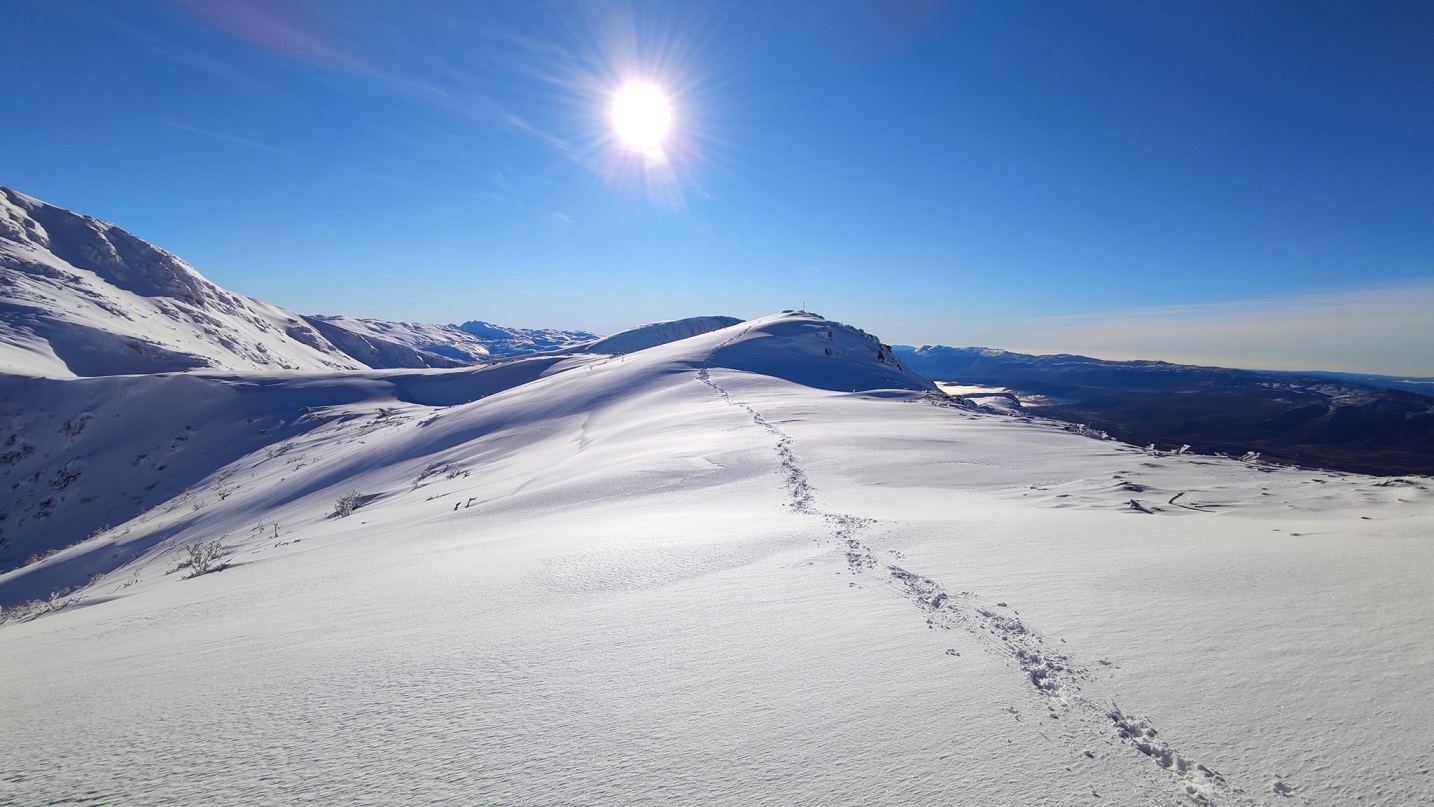
Dinara
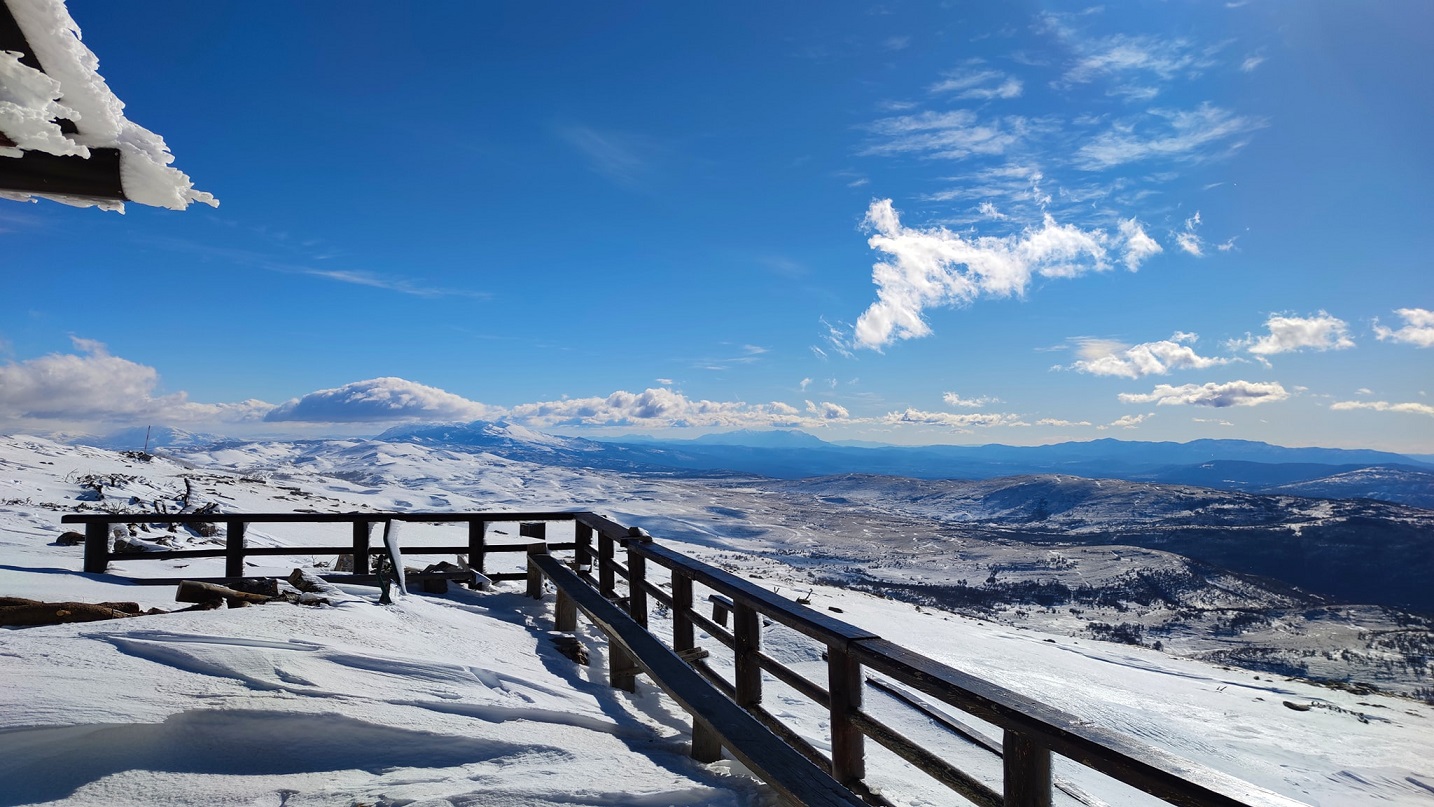
Dinara
"Dinara is so spacious, so beautiful. Of all the mountains on this road, the Dinara has remained most etched in my heart and memory," says Josipa.
Velebit – almost giving up
They walked an average of 25 to 30 kilometers a day to the Dinara, and since they came to Velebit, they had been moving like snails. The weather conditions did not allow them to move faster than 10 kilometers a day.
On Velebit, they again got in a minefield, more precisely a demined area, also due to fog. The fear from Dinara returned. Everything around them was white – down because of the snow, up because of the mist, or clouds in which they were. They were disoriented. Then they realized that it was too dangerous to continue the journey.
Apart from the weather – alternating rain, south wind, bura, minus – their problem was every arrival at the next shelter. There were tears in those moments, they admit.
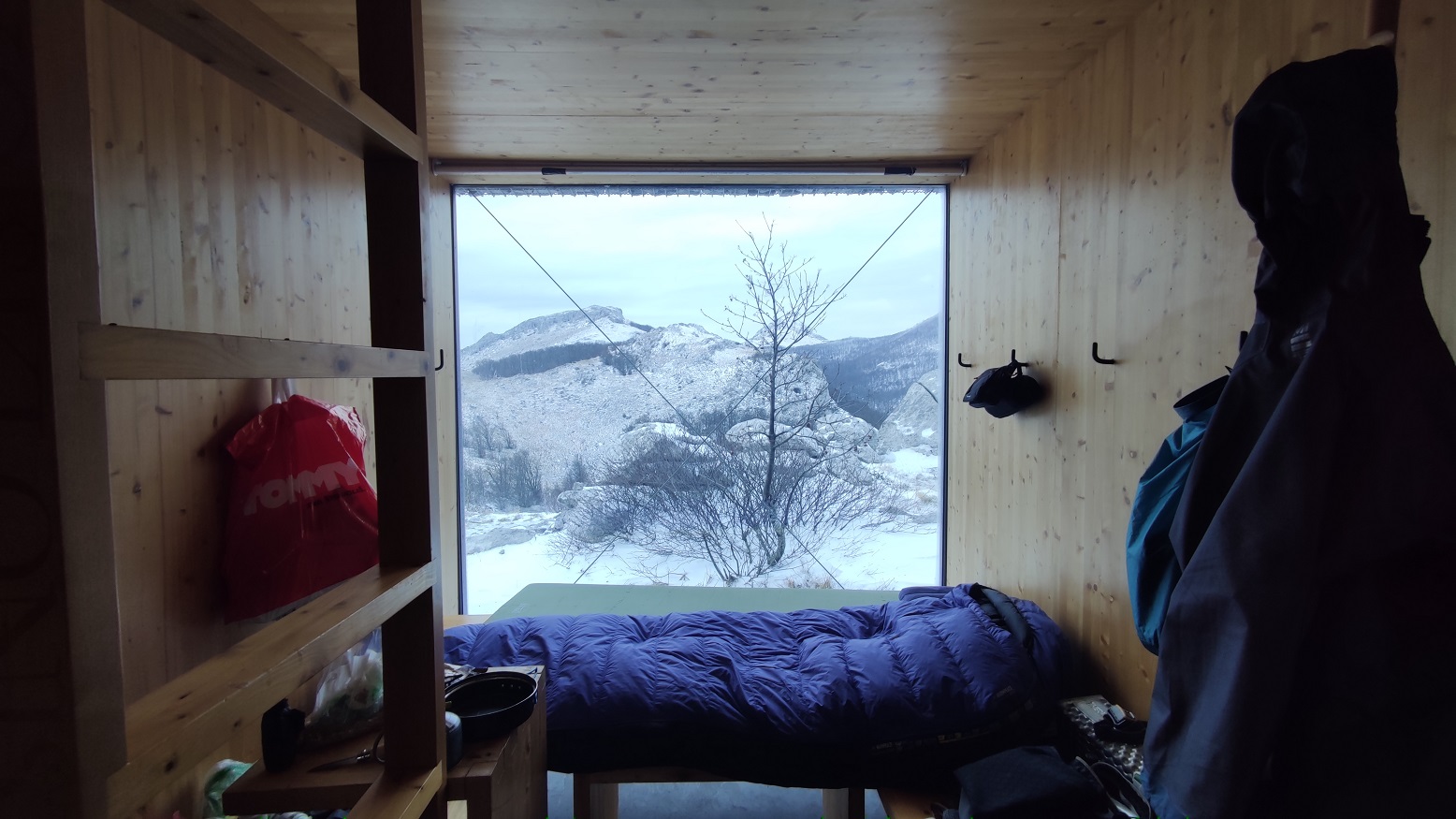
Šugarska Duliba on Velebit

There were some challenging days along the via Via Adriatica trail for this Croatian couple
They could not continue in the rain, especially in the thunder, because it is common knowledge that many mountaineers die due to thunder. However, luck was on their side. One friend drew their attention to a shelter that was not marked on the map, making their journey and planning easier.
On Velebit, they experienced a storm of all storms, with bura gusts of 150 km/h. In places where it pounded them, they barely adhered to sticks, arms, and legs. In one part, the bura even lifted them off the ground.
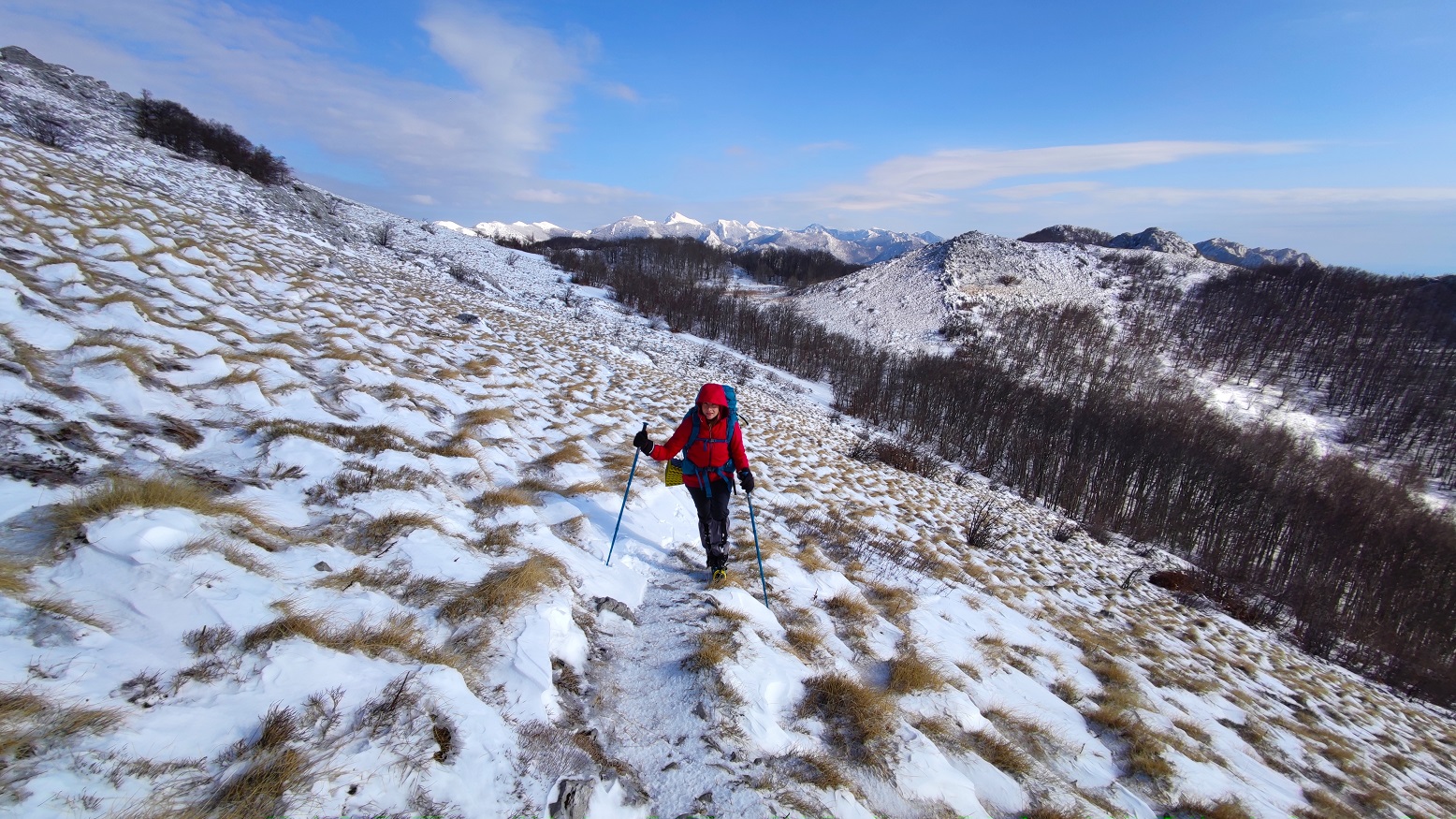
Josipa on Velebit
"Right in front of Baške Oštarije, where a warm bed and meal was waiting for us, the bura was blowing so much that it lifted us off the ground. If we were a pound lighter, we would probably fly into the air," says Josipa, adding that bura and cold take the most energy.
On the famous Premužić trail, cut into the slope, they thought it would be easy. However, when the snow fell, everything froze, and the track did not exist. It cost them time, energy, and nerves. It was a mental and physical breakdown, a difficult period.
"When the weather is great, the terrain is a disaster, and when the terrain is great, the weather is a disaster. Eternal struggle on our path. We were both sad and disappointed after Velebit because of that. Biokovo and Dinara got along so well, then we came to Velebit, and we thought it would be great because it's familiar to us," says Josipa.
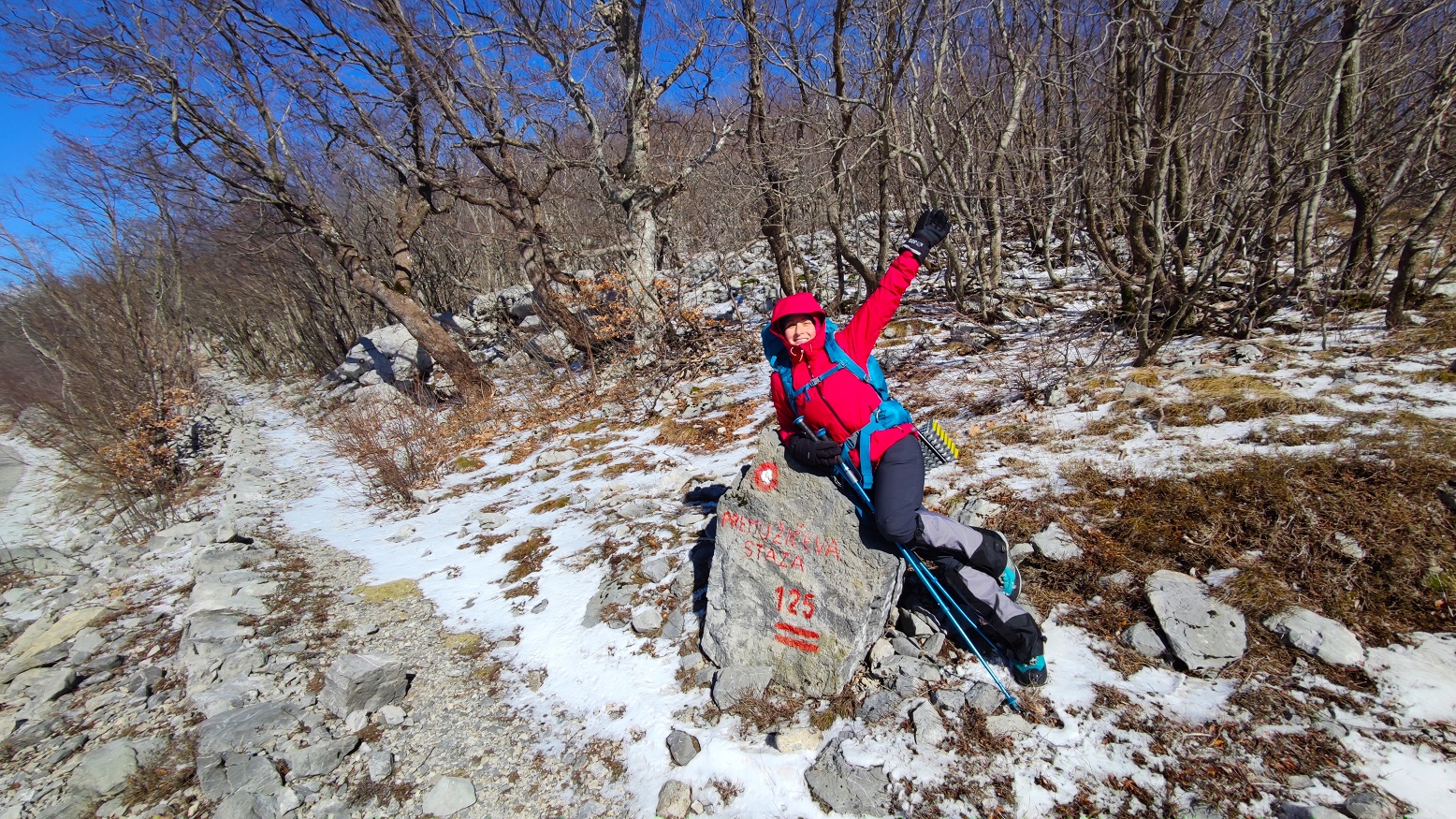
Josipa on Premužić trail on Velebit
Generous help from friends, family, and even strangers
Just before the end of the Via Adriatica trail, in Gorski Kotar, they could barely make their way through the fog, which is why they could not even enjoy the beautiful views. By then, they were slowly fed up, on the verge of giving up, but then, as always in life, friends jumped in. Unselfish support from friends, colleagues, but also strangers came from all sides and gave them extra wind in their backs so that they would not give up when there are already so many successfully traversed sections behind them.

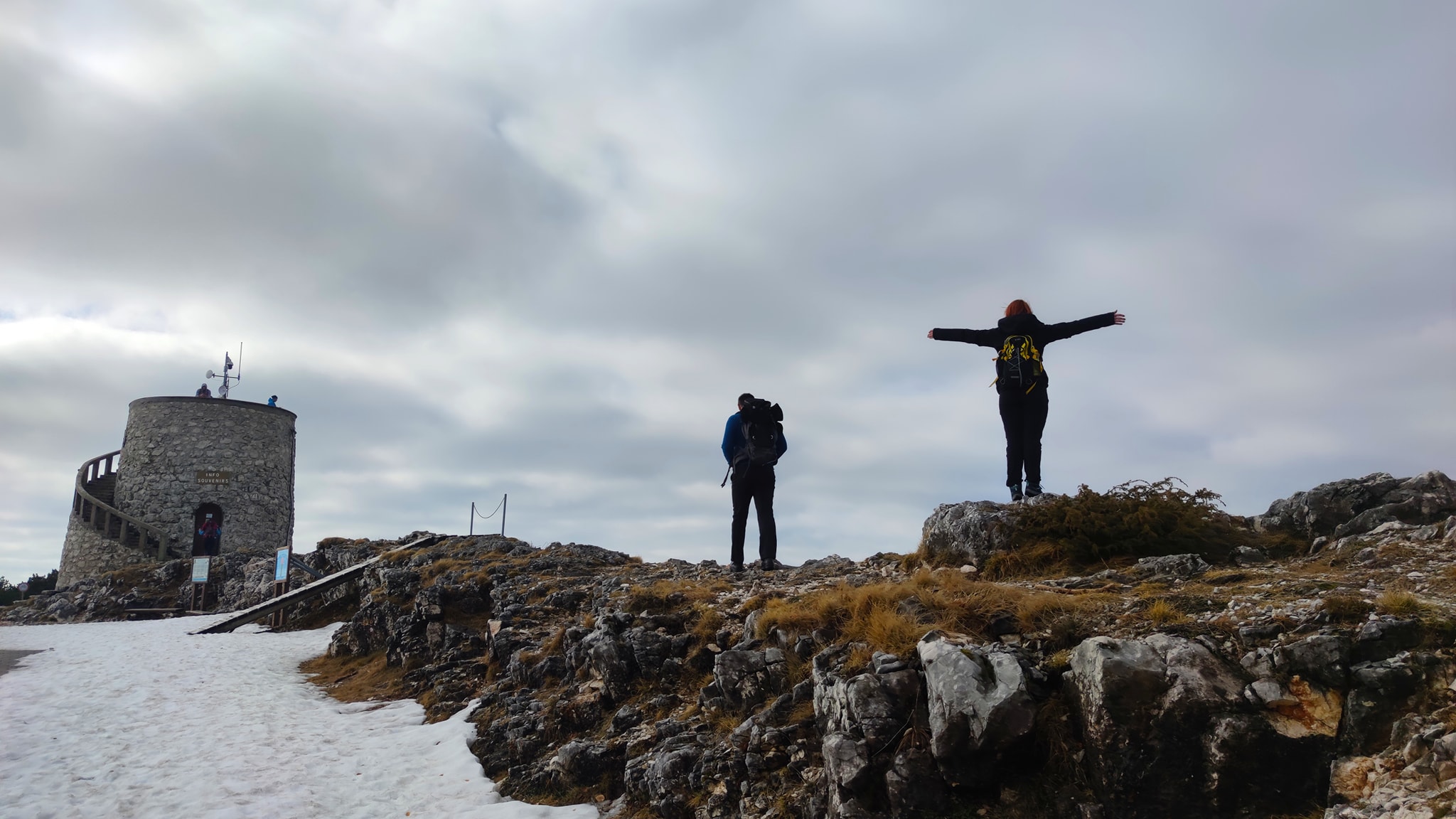
Josipa and Matija on Vojak – the highest peak of Učka mountain in Istria, at the very end of their journey
At Cape Kamenjak, their final destination, they were greeted by family but also by a few unknown people who were supporting them online. Friends couldn't welcome them because of work, but they're preparing a party on Saturday to frame and mark this whole story.
Although they hoped to finish the trail in mid-February, the weather proved to them to be patient and that sometimes things had to go according to nature's plan, not human's. They became patient with each other as well.
"When you spend so much time together, 0-24, you have to make some compromises. As a couple, we function very well, and we support each other when it is hardest," says Josipa.
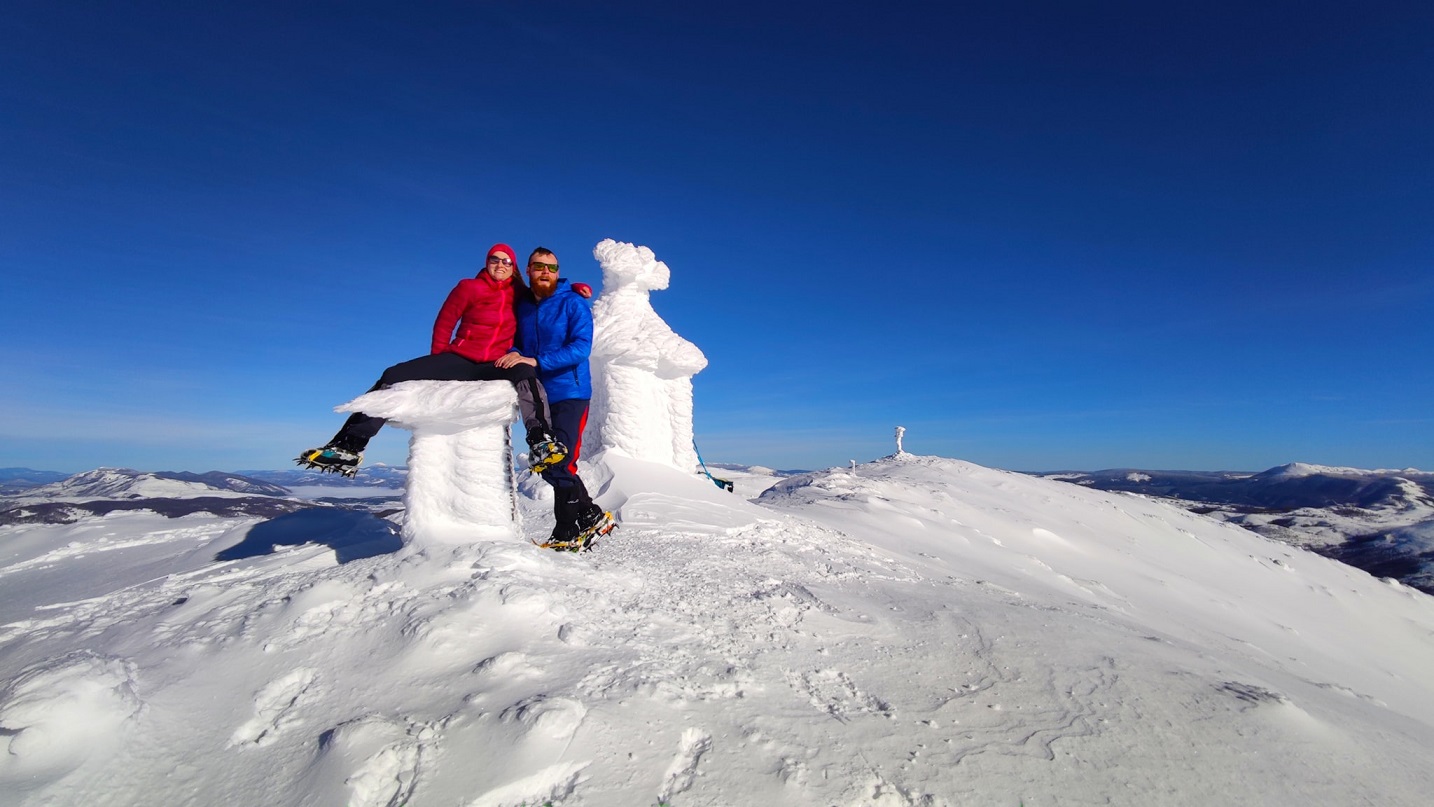
Josipa and Matija on the Sinjal Peak – highest peak of Dinara and whole of Croatia
Except for roe deers and a few lynxes, they didn't see any wild animals along the way, only a multitude of wolves' and bears' traces, small and large. Also, they were mostly alone along the way, occasionally accompanied by a group of other mountaineers, as well as some beautiful and lovely dogs. However, as they say, they would not survive this trip without the generous help of their friends from Mountaineering Association Vrlovka, who would come and wait for them along the path to give them food and equipment. The fearless team of that mountaineering association even walked with them on Velebit's part while a strong bura wind was blowing, providing Josipa and Matija immense support.

'We wanted to promote the beauty of Croatia, Via Adriatica trail, and active lifestyle'
When asked whether they would dare to retake this path, they agree they wouldn't after all the troubles they faced along the way. But, if asked that question in a week or two, they would definitely say yes, but only under better weather conditions.
Winter has its charms, but it is also exhausting. It requires a lot of hiking equipment, and it is much more dangerous to go in winter than at any other time of year. If Josipa and Matija could choose, they would go in the spring or late fall. When in the mountains in Croatia, one should be humble and patient.
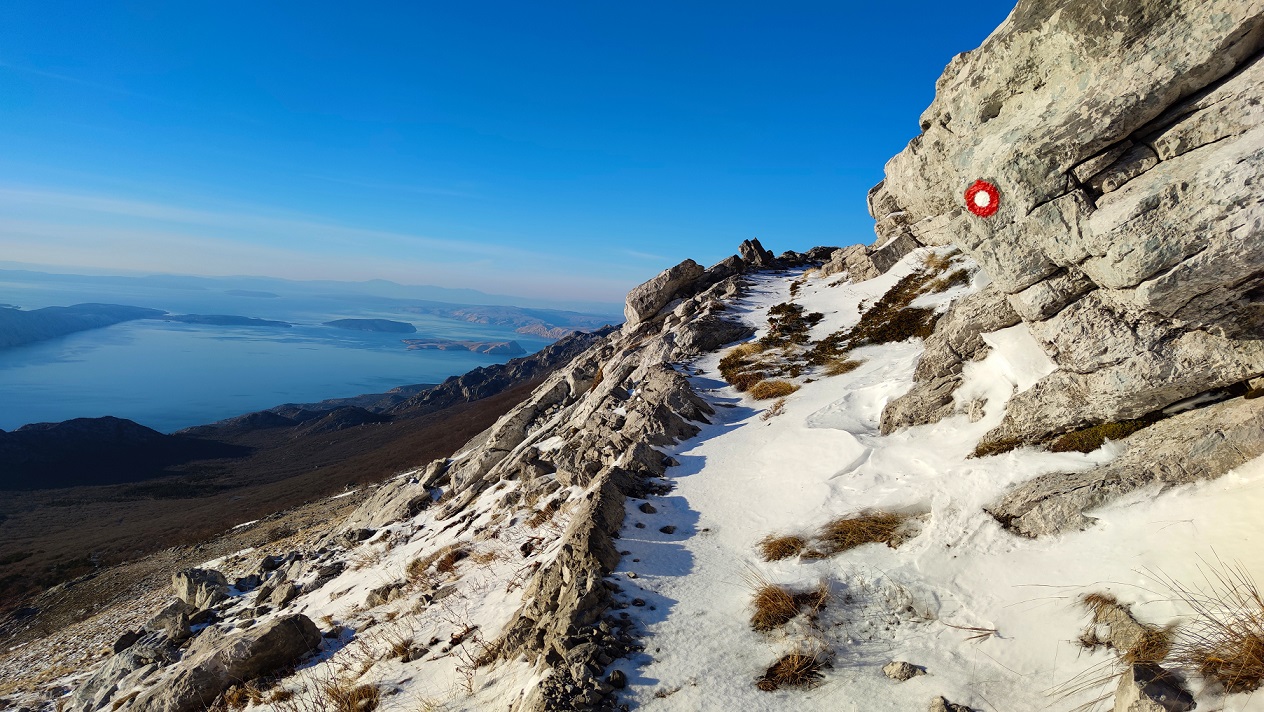
View of Croatian islands from Velebit
"Our goal was to promote the beauty of Croatia, to promote Via Adriatica, and to promote an active lifestyle, especially now at this time of the corona when we are all locked in our homes. I think that hiking is a wonderful hobby, both for the body and for the mind, whether in a company, in a couple, or alone," says Josipa.
Although Josipa and Matija are experienced mountaineers (Matija is even a member of the Croatian Mountain Rescue Service – HGSS), the tour was very demanding for them, both physically and mentally. Considering that they only got a chance to set off on Via Adriatica now, during winter, because Matija's work has been banned and Josipa is having a vacation, the winter conditions did not favor them. But regardless, they enjoyed the inexplicable natural beauties of Croatia and met many generous life-long acquaintances along the way.
"It's hard to describe all those feelings that go through your mind and heart along the way. To understand what we are talking about, it is the best to set out on such a journey on your own," advise Josipa and Matija.

All the photos are from interlocutors' private archives.
You can follow Josipa and Matija and their other hiking journeys on their Facebook page.
For the latest travel info, bookmark our main travel info article, which is updated daily.
Read the Croatian Travel Update in your language - now available in 24 languages.
Croatian Couple Set Off on 1,100 km Via Adriatica Trail to Promote Croatian Beauty
January 22, 2021 – As a New Year's resolution, the Croatian couple decided to set off on one of the longest and most demanding mountaineering ventures in Croatia – the Via Adriatica trail. Starting at Prevlaka, this is their 21st day of walking towards Cape Kamenjak in Istria. Delighted by Croatia's views and the hospitality of the people they met along the way, Josipa and Matija happily make their way through the first long-distance trail in Croatia.
The Via Adriatica trail combines existing hiking trails, forest roads, macadam, and roads in a total of 1,100 kilometers with 41,000 meters of altitude difference. The trail connects Croatia's most beautiful mountain massifs, peaks, and landscapes, stretching from the Istrian peninsula across the Croatian mountain threshold all the way to the Prevlaka peninsula.
As its name suggests, it connects the most attractive Croatian mountain massifs, peaks, and regions along the Adriatic coast. It passes through three national parks, three nature parks, six significant landscapes, three special reserves, and many protected areas.
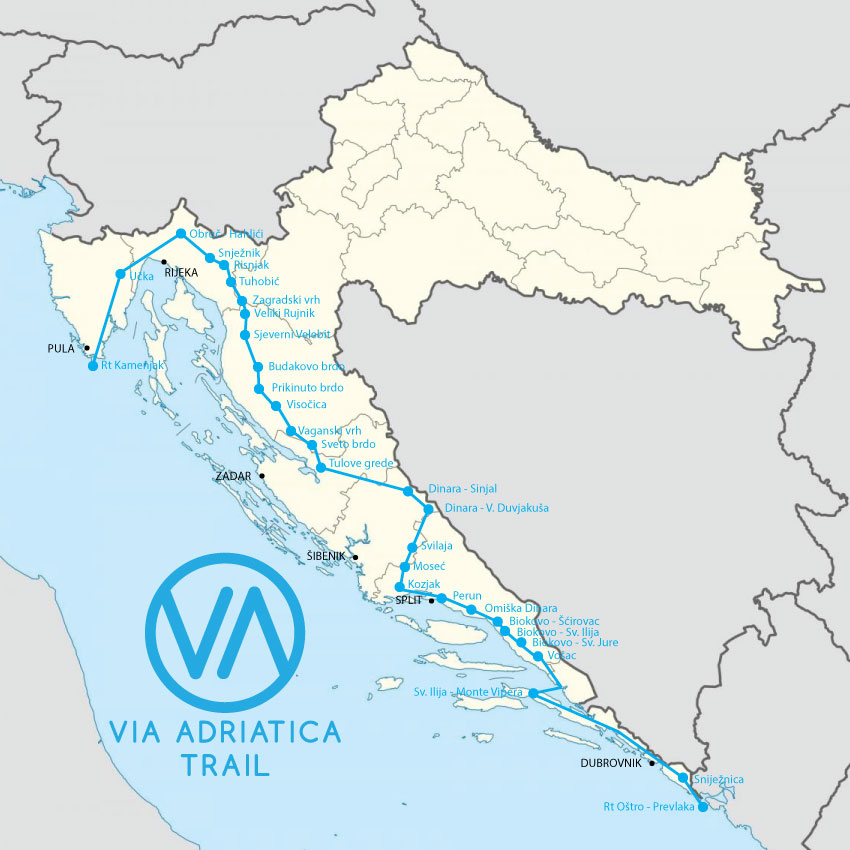
Via Adriatica trail
If we go in concrete figures, Via Adriatica goes along 14 mountains, 12 rivers, two lakes, 18 protected areas, seven counties, and 52 municipalities. What makes this trail attractive and popular among Croatian and foreign hikers are the sea and island views wherever it is possible.
Josipa and Matija, a young romantic couple from Croatia, are now on the way to Svilaja, a mountain in the Dalmatian hinterland. Although sighing from the constant walking with heavy backpacks on their backs, they tell their story of how, when, and why they decided to head to this fantastic Croatian long-distance trail right now, in January.
'We got in the car and left'
Both Josipa and Matija are natives of Karlovac and hiking enthusiasts, chasing each their careers, which allowed them two months of a completely new mountaineering experience due to a combination of circumstances. Josipa (27) has a master's degree in economics, works as a reception manager in one Zagreb hotel, while Matija (25) runs his own business in an adventure travel agency in Karlovac.
In mid-November last year, they discussed what they would do in January and February since there is not much in Zagreb hotels at that time of the year. When Matija was banned from working on December 1, they decided to go on the Via Adriatica trail to promote Croatia, its beauties, Matija's company, but also – themselves.

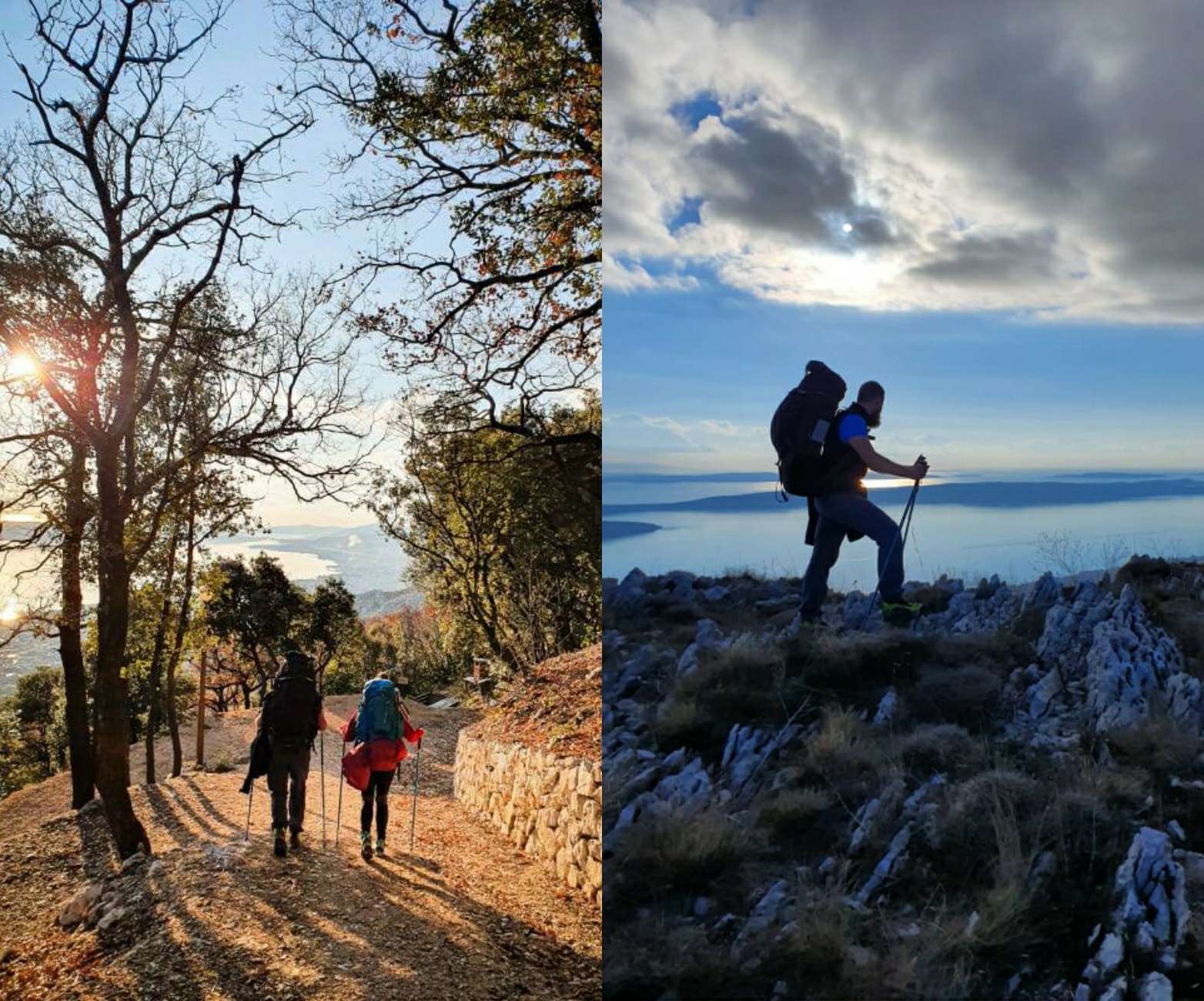
Josipa and Matija, Kozjak mountain
"We have time until the end of February, but we took more time than the average time needed to pass Via Adriatica because we took into account winter and unforeseen circumstances. We already know that we will have to take a three-day break this week due to heavy rain and stormy jugo wind," Matija told the Dalmacija danas portal, which caught up with them in Žrnovnica. They were hosted by the Association Žrvanj, which makes its premises available to all hikers who decide to cross the entire Via Adriatica.
For Josipa, as she says, Via Adriatica was a great idea, but it never crossed her mind to set off on this, not at all simple, but beautiful trail. However, she took advantage of this unique opportunity and, together with her beloved Matija, a member of the Croatian Mountain Rescue Service (HGSS), set off on an adventure.
"In December, we didn't know if we were going to leave or not. There was quarantine, bans, passes. Until the last three days, we didn't know if we were going. Then the earthquake happened, and again it was a question of whether I would go to the rescue or not. Given the time invested in preparation and all the equipment, we said we were going. We got in the car and left," says Matija.
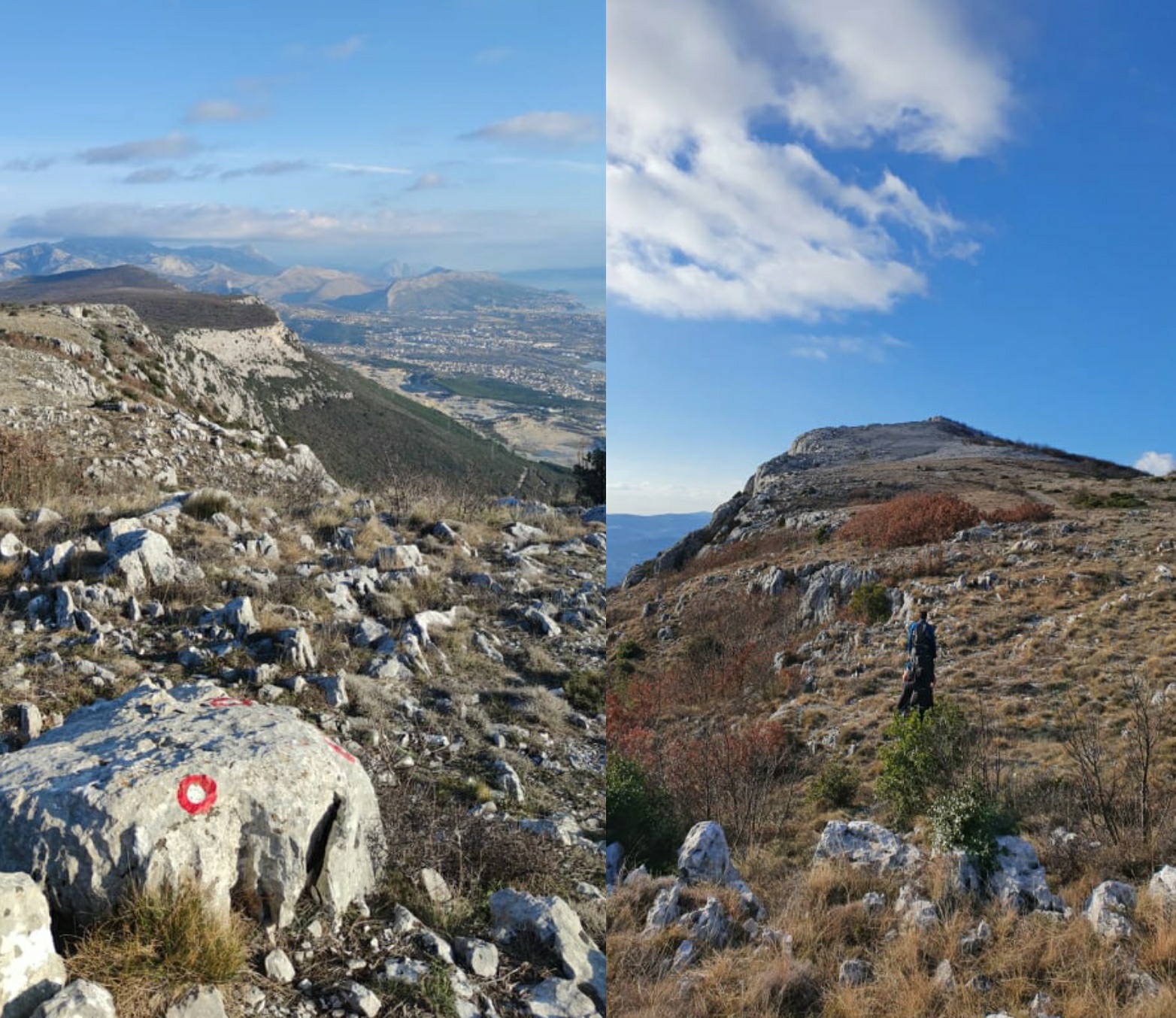
Kozjak mountain
'People make the whole trail special'
Although Via Adriatica starts in Cape Kamenjak in Istria, Josipa and Matija decided to start from the last destination in Prevlaka, to be closer to home in Karlovac at the end of the trail.
"The idea was to be in Dalmatia for the first few weeks, while we have supplies of food and then start getting closer to home. It's more natural to get closer to home than the other way around. We celebrated the New Year, and in the morning, we left Prevlaka," says Josipa.
"The first two or three Via Adriatica's sections are quite flat. When you walk on the flat for a long time, you get bored. Pelješac is beautiful, the view from Sveti Ilija, the highest peak of the Pelješac peninsula, is magnificent, but it takes so long to get there! We only reached the 'real' mountains after Pelješac – Biokovo, Omiška Dinara… Perun has beautiful views," says Matija, emphasizing that the most beautiful parts of the trail are – the people.

On the fifth section, Josip and Matija had good company - members of a mountaineering association
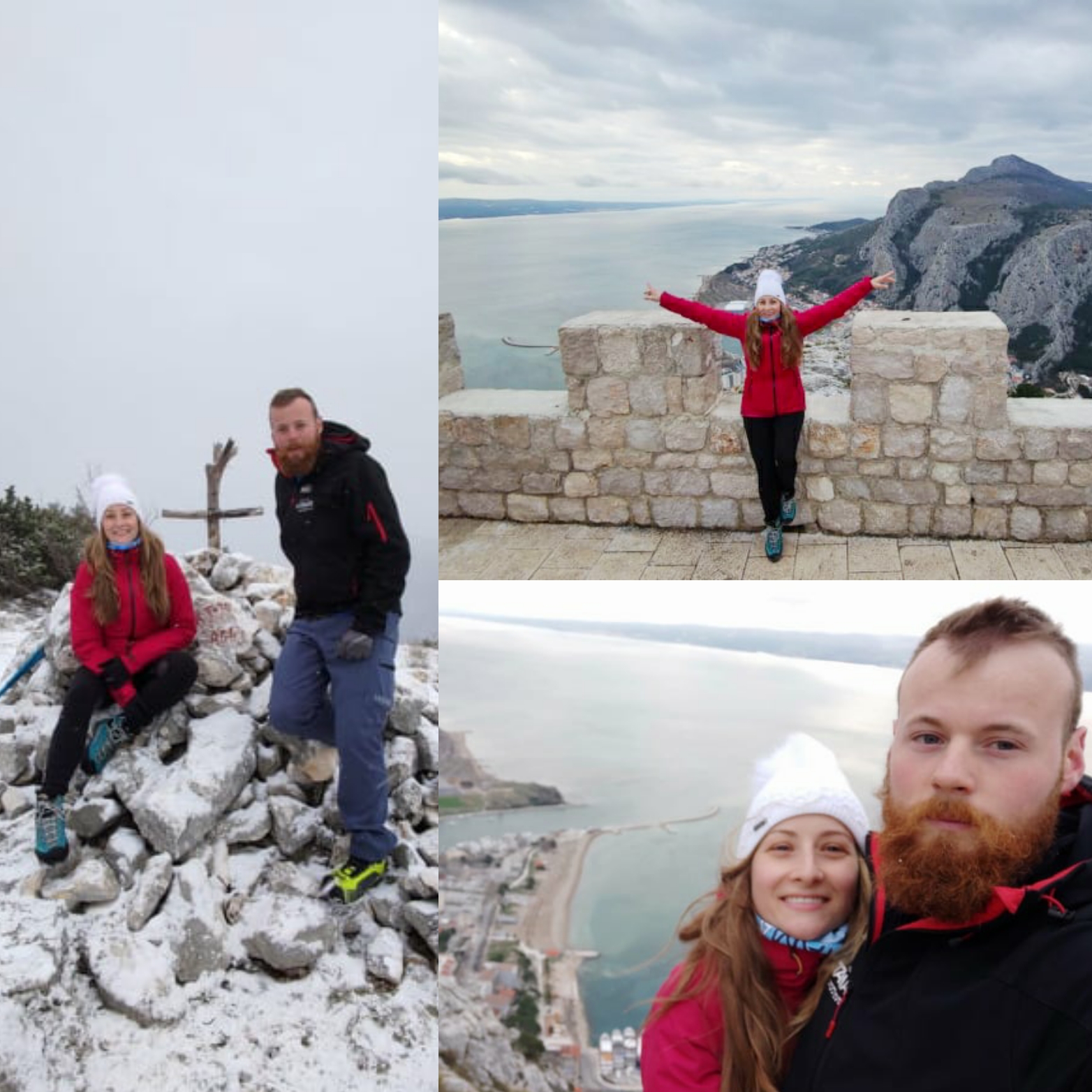
Josipa and Matija at Omiška Dinara
"People make the whole trail special. People selflessly give you their home, food, hospitality. There is no doubt that this path would be five times harder if people did not help. It wouldn't be impossible, but it would be a lot harder. If we had to sleep in the winter in a tent every night, it would not be easy. This way, when you know that warm accommodation awaits you in the evening, you are mentally better prepared. People feed us and take care of us," says Matija.
As they talk to us, they are on the sixth section of Via Adriatica, out of 13. Another 600 kilometers is still in front of them, but they are satisfied with their pace. With a laugh, Josipa says they are breaking through the thorns.
Best views they've ever seen
Before Via Adriatica, they visited Biokovo several times, but always during summer when everything is "stone and heat." They experienced it for the first time in the winter, and they say it was impressive.
"We imagined Biokovo white with huge vastness. And it greeted us exactly like that; icy, white. The weather was perfect; the snow was perfect for walking. We walked in crampons because everything was frozen. Although it was icy and cold, it was sunny, like in a movie. It was snowing on the Omiš Dinara, the large snowflakes falling," describes Josipa.

Snowy Biokovo

View from Biokovo
Then followed Perun or Poljička mountain. Perun, says Matija, is not Biokovo, but it has its charms.
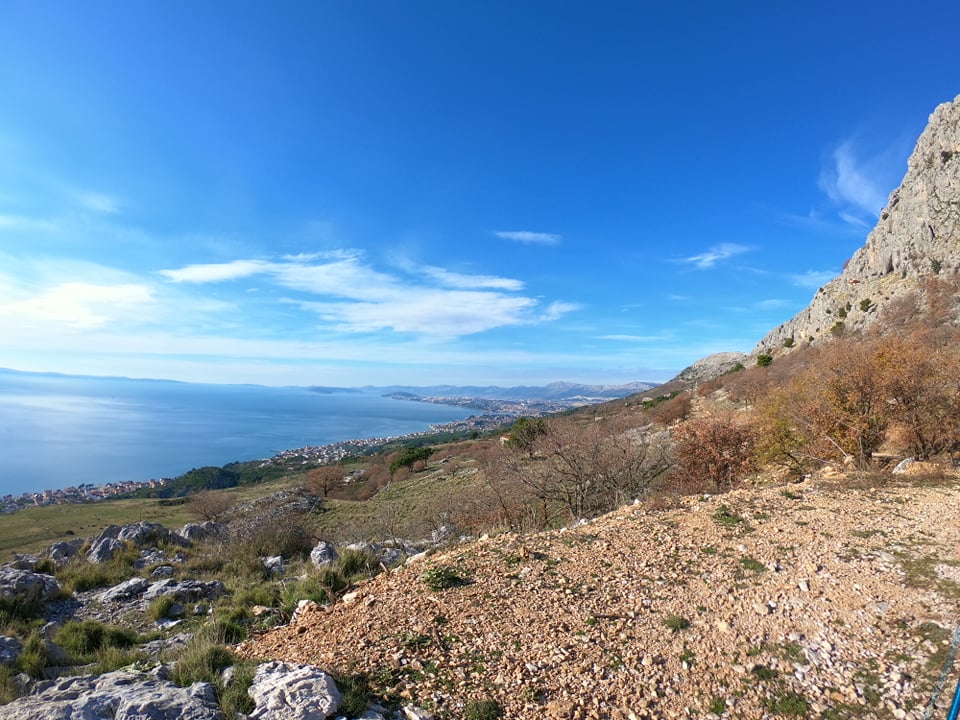


Capturing beautiful moments on their way to Perun
"From Omiš, you go a little towards the village of Gata, so the ascent to the chapels begins, and then descends to the seaside, which is beautiful, with a view of the islands. The moment when Split appears in front of you is especially impressive. So far, I've seen Split from all sides, even from a helicopter, but this is the best view of Split I have ever seen. Brutal," says Matija.
The northern part of Dalmatia - the Dinara mountain, the Lika region, and Velebit mountain - are still waiting for them. The journey is challenging but also exciting.
"Dinara and Velebit are our next challenges. Dinara is quite laid, and I think it will be relatively easy. We know it will all be covered in snow. On Velebit, Vaganski Vrh and Sveto Brdo, two highest Velebit peaks can be quite tricky, especially if those huge cliffs freeze," says Matija, but points out that they are well prepared.
Good equipment is the key
So far, they have not even used all the equipment they brought with them, and they were at a temperature of -15 degrees Celsius with a strong wind. They have high-altitude hiking boots, sleeping bags that can withstand -20 degrees. They also have a real expeditionary Himalayan tent for two, weighing a little less than 4 kilos, wind-resistant over 150 km / h.
"We mostly relied on obtaining quality and safety equipment. Since we travel in the winter, we needed good winter equipment that can withstand low temperatures. I think we did our best in researching for good equipment. We have quality equipment, and we are ready to sleep in winter conditions," says Josipa.
She doesn't check her phone very often, and the signal is lost every now and then, so it's harder to communicate. However, that doesn't bother them – they have each other.

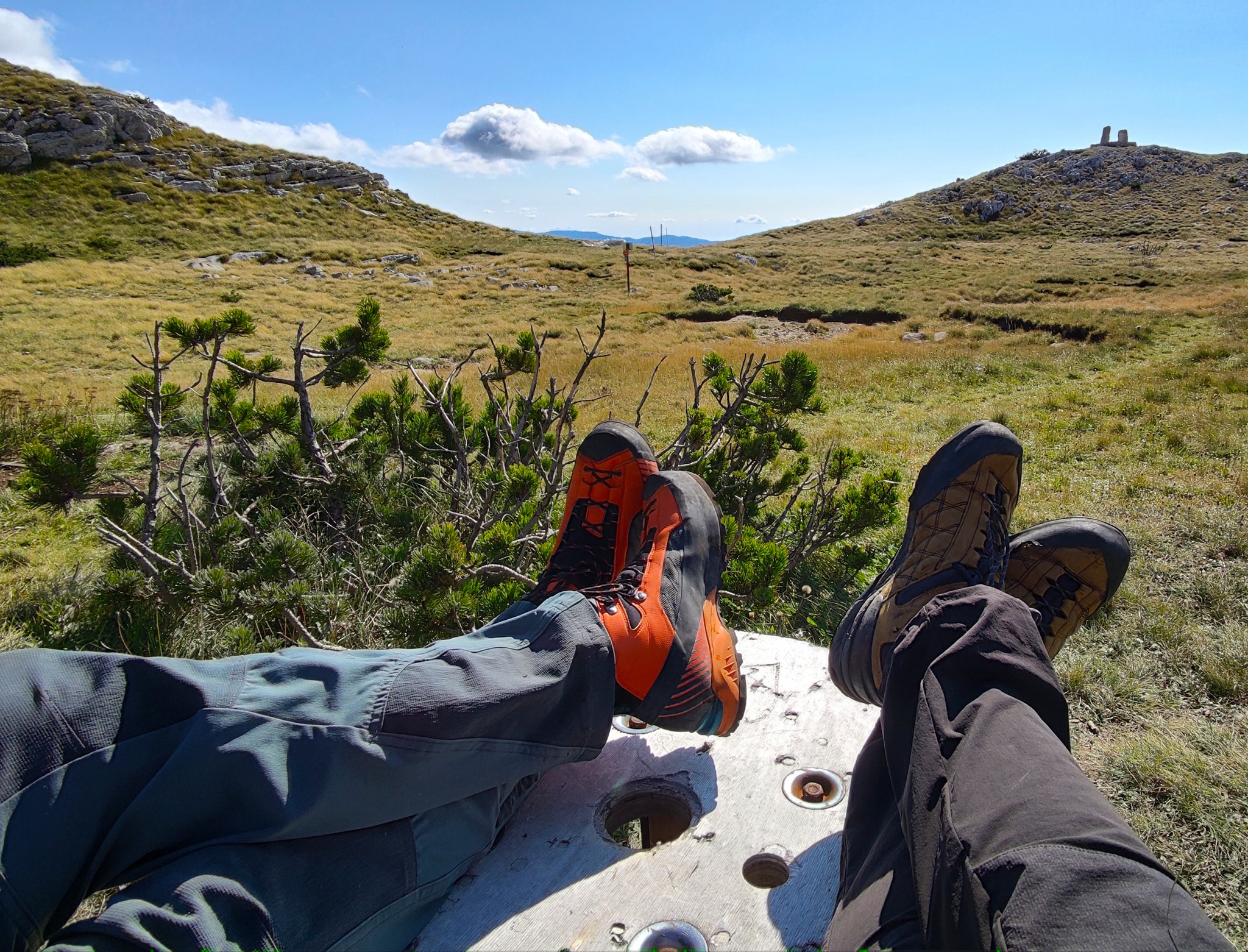
Josipa and Matija
When asked how much it took them physically to prepare for such an endeavor, they say that they are in the mountains every weekend and spend all their spare time in the mountains, so they do not physically prepare too much.
"As for mountaineering life, we are very active. We crossed both easier and harder climbs, both in summer and winter, so we are well prepared. And mentally... I don't think you can mentally prepare for that until you face the path itself. You have some idea what it might look like, but until you find yourself there, you don't know," says Josipa.
Prepare, don't rush, and enjoy the fantastic scenes
And that hiking is becoming a popular hobby in these new circumstances is confirmed by the story of Marin Zovko, who, combining Via Adriatica with the Croatia Long Distance trail, recently walked the whole of Croatia in just 100 days. He decided to embark on his adventure alone and later admitted that loneliness had fallen hardest on him.
Josipa and Matija, more or less, always hike together and often mountaineer in larger groups since they are active members of the mountaineering society. Apart from the company that the hiking companions provide, Josipa says that it is good to hike in the company for safety reasons.
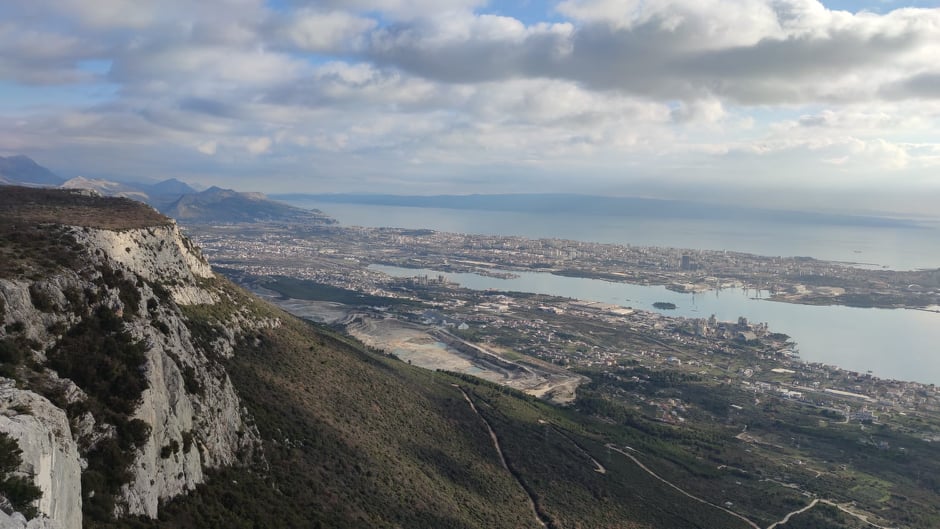
View from Kozjak
"Honestly, I would never dare to undertake such an endeavor alone. Matija knows a lot about the mountains, and since he is a member of the HGSS, we are in safe hands," says Josipa happily.
They recommend people to enjoy the trail, not to rush, but to prepare.
"It takes a lot of courage and a lot of madness to set out on a journey like this, but the trail takes back everything a hundredfold. We watch amazing scenes, and we get to know our country even better. Whoever is interested in something like this, I would recommend it from the bottom of my heart, "says Josipa.
We now let them continue their journey in peace, enjoying all the natural beauties surrounding them because they are quite exhausted due to the Via Adriatica venture's daily demands.
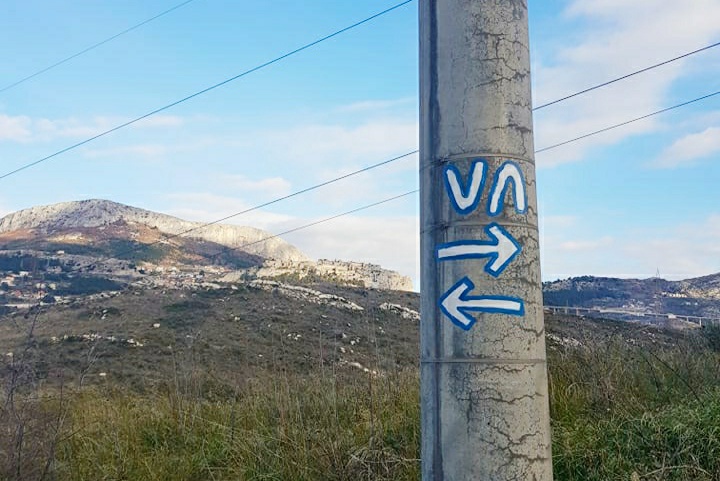
All the photos are from interlocutors' private archives.
To follow more news from their Via Adriatica adventure, you can find them on Facebook.
For the latest travel info, bookmark our main travel info article, which is updated daily.
Read the Croatian Travel Update in your language - now available in 24 languages.
Highlander Programme 2021: International Success for Croatian Brand
As Poslovni Dnevnik/Marta Duic writes on the 17th of December, 2020, three friends from the Eastern Croatian city of Osijek, Igor Mlinarevic, Jurica Barac and Andrej Mlinarevic, are passionate lovers of mountains and hiking. They officially presented the Highlander programme 2021 in front of the Egyptian pyramids in Giza, not far from Cairo.
The organisers of this mountaineering event have devised a Highlander mountaineering story, which is slowly conquering the whole world and becoming a global phenomenon. As they say, the reason for choosing Egypt as the location for the presentation of the Highlander programme 2021 lies in the fact that the Egyptian Bedouins, a nomadic people, were some of the first hikers in the world. One of the most important goals of this event is the promotion of an active and healthy lifestyle through hiking, as well as the preservation and care of nature by promoting the so-called Leave No Trace philosophy, and their wish is that in the future, the Highlander event manages to obtain the status of "100% Green Event".
Interest is growing...
Here in Croatia, Highlander is held on Velebit, and in 2020, it was held for the fourth time. The group also record a continuous growth of participants. Back in 2017 there were 60, and this year there were an impressive 330. In addition, Highlander has other variants in countries such as Serbia (Stara Planina), Bosnia and Herzegovina (Blidinje), Montenegro (Durmitor) , Austria (Murau) and Greece (Olympus), and at a press conference held in Egypt, new countries announced their own ''joining'' to the list; Morocco (Toubkal), Portugal (Melgaço), Northern Macedonia (Ohrid), Spain (Duero-Douro), Saudi Arabia (Abha), the United Arab Emirates (Ras Al Khaimah), Slovenia (Julian Alps), Russia (Caucasus) and Egypt (Qusoor El Arab).
Namely, at the beginning of 2020, this team sold the Highlander license to four neighbouring countries: Serbia, Bosnia and Herzegovina, Austria and Greece. As such, Highlander Global became an umbrella organisation that oversees existing and new Highlander countries, and in 2021, there will be about 15 Highlander events held around the world.
''After three years of developing this event here in Croatia (Highlander Velebit), we decided to sort out a franchise last year because we'd created a concept that doesn't currently exist, has an excellent business model and isn't demanding to implement. As such, at the end of 2019, we sold licenses to Austria, Serbia, Bosnia and Herzegovina and Greece.
As soon as 2020 came around and as soon as we announced new markets, we started talks with our partners around the world and negotiated the sale of the license to other countries. Then the coronavirus pandemic struck and everything slowed down, but fortunately, there are entrepreneurs who see an opportunity in everything, including the pandemic, and it's with these visionaries that we've agreed on ten more markets for 2021. The main motives are the huge growth of interest in outdoor sports, great interest in adventures such as Highlander and mountaineering tourism development strategies that are increasingly common due to their sustainability, positive impact on human health and an additional influx of guests,'' says Jurica Barac, the director of Highlander.
For the latest travel info, bookmark our main travel info article, which is updated daily.
Read the Croatian Travel Update in your language - now available in 24 languages


